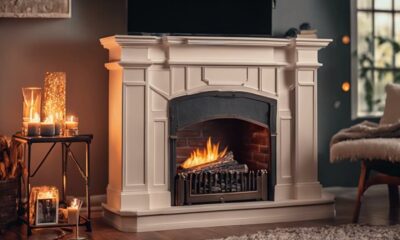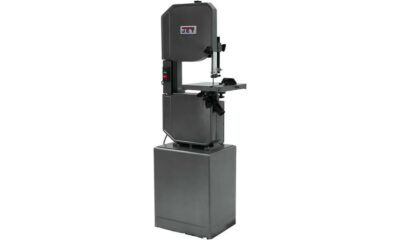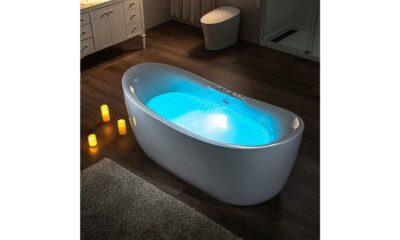Home Decor
Why Urban and Rural Interiors Vary So Much?
Navigating the contrasting worlds of urban and rural interiors reveals fascinating influences that shape their unique aesthetics and functions. What drives these differences?
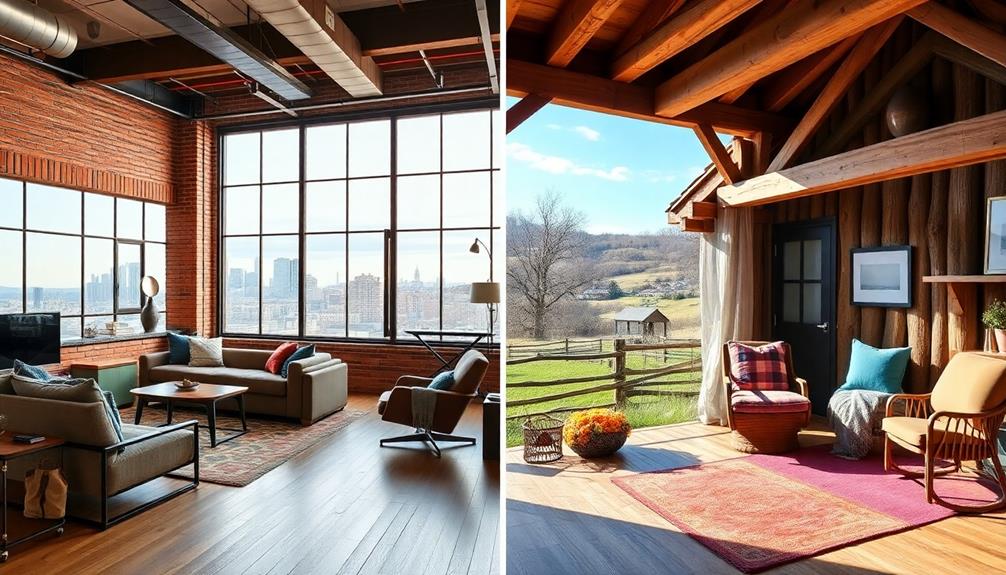
Urban and rural interiors vary greatly due to distinct historical, economic, and cultural factors. In urban areas, you'll notice sleek designs using modern materials like steel and glass, shaped by industrialization and high property costs. Rural interiors, on the other hand, embrace traditional craftsmanship with locally sourced materials like wood and stone. Community dynamics play a role too; urban life often feels fragmented while rural homes promote face-to-face interactions. Environmental considerations also differ; rural settings offer cleaner air and more natural elements. By exploring further, you can uncover the deeper influences that make these spaces uniquely appealing.
Key Takeaways
- Urban interiors prioritize modern aesthetics and space efficiency due to higher property costs, while rural designs emphasize traditional materials and craftsmanship.
- Cultural narratives shape urban spaces as sleek and sophisticated, contrasting with rural homes that reflect community-focused identities and heritage.
- Economic factors influence material choices, with urban areas using contemporary construction materials, while rural designs utilize locally sourced, traditional materials.
- Sustainability drives urban designs towards high-density living and smart technology, whereas rural designs incorporate natural elements and traditional sustainable practices.
- Community dynamics differ, as urban life often relies on virtual interactions, while rural settings foster face-to-face connections and community-oriented layouts.
Historical Influences on Design
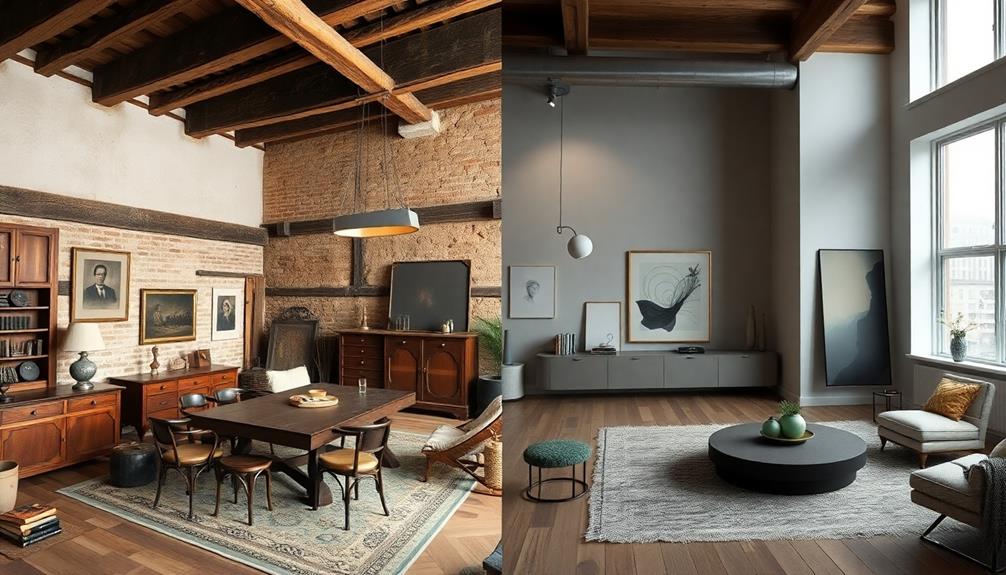
Throughout history, design has been heavily influenced by the contrasting lifestyles found in urban and rural settings. In rural areas, historical influences romanticized the wilderness, giving rise to a design ethos that emphasizes traditional, locally sourced materials and sustainability. You can see this in rustic homes that reflect the surrounding landscape, showcasing a connection to nature and community.
This appreciation for craftsmanship is akin to the way Indonesian Decor Masks highlight cultural heritage through intricate designs and vibrant colors.
On the flip side, urban interiors evolved considerably due to industrialization and modernization. Higher population densities drove the adoption of modern architectural designs and advanced construction techniques. Urban spaces prioritized convenience and access to amenities, resulting in sleek, functional designs that cater to busy lifestyles.
Furthermore, architectural movements like the Garden City concept aimed to integrate urban design with surrounding rural environments, impacting interior layouts in both settings.
It's interesting how cultural narratives have also shaped these distinctions; stereotypes of rural areas as backward contrast sharply with urban sophistication, reinforcing unique design preferences. By understanding these historical influences, you can appreciate why urban and rural interiors differ so considerably, each reflecting the values and lifestyles of their respective communities.
Economic Factors Shaping Interiors
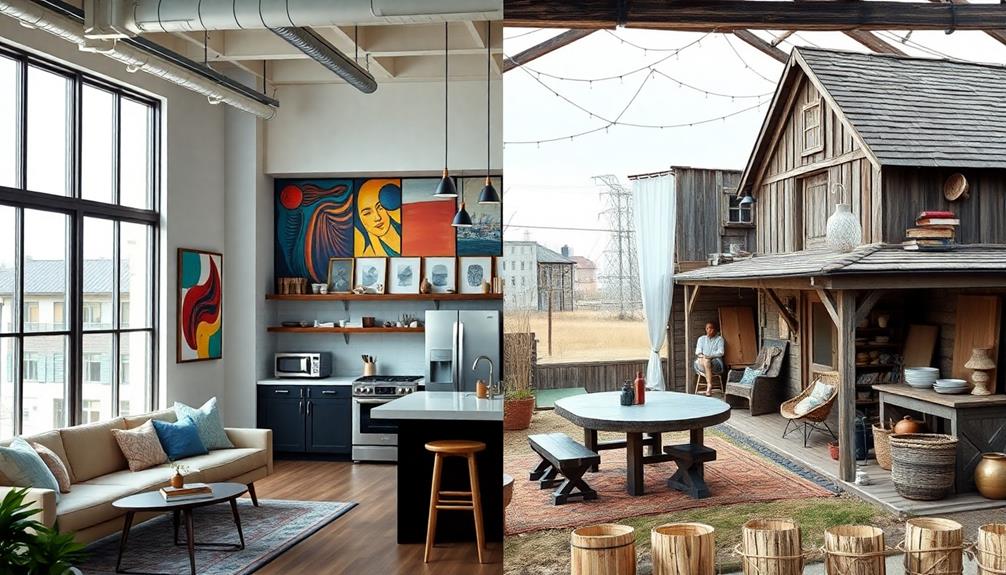
Economic factors play an essential role in shaping the interiors of urban and rural spaces. In urban areas, higher property costs push homeowners to maximize space efficiency, often resulting in multifunctional designs that fit into smaller living areas. You might notice that urban interiors prioritize modern amenities and technology, reflecting the concentration of job opportunities and a lifestyle that values convenience.
Additionally, urban designs may incorporate elements of Balinese design characteristics, such as open spaces that enhance social interaction and relaxation.
Conversely, rural interiors typically showcase traditional architectural styles and locally sourced materials, thanks to lower property costs and a strong cultural connection to the land. You'll often find spacious layouts that emphasize privacy and personal space, contrasting with the communal aspects of urban living.
Moreover, government incentives in rural regions can encourage unique interior designs focused on sustainability and energy efficiency. In urban settings, however, luxury and convenience often take precedence. The abundance of amenities in cities fosters a social lifestyle, leading to interiors that incorporate communal spaces for interaction and entertainment.
Ultimately, these economic factors shape how we experience our environments, influencing the design choices that define urban and rural interiors.
Cultural Perspectives and Narratives
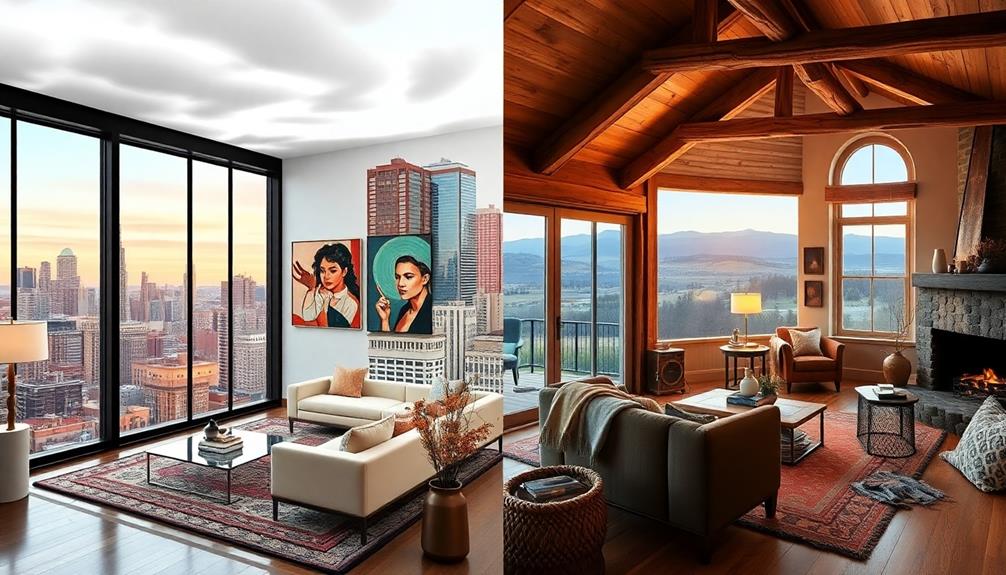
When you think about the contrast between urban and rural interiors, it's clear that cultural narratives play a huge role.
Urban spaces often embrace a sleek, modern aesthetic shaped by stereotypes of sophistication, while rural homes tend to reflect a more traditional, community-focused identity.
This is evident in the use of decor elements such as Indonesian Decorative Pillows that add vibrant colors and intricate patterns to living spaces.
Understanding these evolving narratives can help you appreciate how they influence design choices in both settings.
Historical Urban-Rural Contrast
The historical contrast between urban and rural environments reveals deep cultural narratives that have shaped American identity. Early American views often romanticized the rural landscape as idyllic and pure, creating a stark contrast with the emerging industrial city life, which was frequently depicted as dirty and chaotic.
As the country evolved from a primarily rural population to urbanization over the last century, these narratives evolved. Rural areas began to be stereotyped as backward, while urban dwellers were portrayed as sophisticated and modern. This shift also coincided with an increasing appreciation for designs that incorporate natural elements, such as those found in traditional Indonesian style home decor, which emphasizes harmony with nature.
Architectural movements like the Garden City concept proposed by Ebenezer Howard aimed to integrate urban and rural spaces, reflecting a historical desire to harmonize these contrasting environments. This vision has influenced urban planning, encouraging the blending of natural elements within cityscapes.
As the urban landscape transformed, perceptions shifted from cramped and unsanitary cities to vibrant and architecturally significant spaces.
Yet, cultural narratives surrounding urban vs. rural lifestyles still perpetuate a divide, impacting residents' identities and the architectural frameworks defining their environments. Understanding this historical context helps you appreciate how these contrasting perspectives continue to shape contemporary urban and rural interiors.
Stereotypes of Rural Life
Stereotypes surrounding rural life often paint a picture that doesn't reflect the real experiences of those living in these communities. Many people view rural residents as backward or lacking sophistication, contrasting them with the perceived refinement of urban dwellers. These narratives shape cultural perceptions, suggesting that rural life is merely a romanticized version of simplicity and authenticity, while urban spaces represent modernity and progress.
In Indonesia, for example, traditional housing such as Rumah Adat embodies the rich cultural heritage and craftsmanship that rural communities possess, challenging the notion of inferiority.
However, this oversimplification can lead to a loss of cultural identity among rural residents, especially as urban developments encroach upon their traditional lifestyles. They often feel a sense of cultural invasion, leading to defensiveness about their values and way of life.
While some may see rural residents as resistant to change, this stereotype limits opportunities for younger generations who've a strong connection to their roots.
The reality is that rural residents defend their identity fiercely, reflecting on their values and creating a deep sense of place and community. This contrasts sharply with the transient nature of urban living, highlighting that rural life is rich with complexity, deserving of respect and understanding beyond mere stereotypes.
Evolving Cultural Narratives
Cultural narratives are constantly evolving, reshaping our understanding of both urban and rural environments. Early American narratives romanticized wilderness, creating a stark contrast with the industrialized urban spaces that developed later. This shift influenced how you perceive interior design in both settings.
Urban areas once viewed as dirty and cramped have transformed into modern, architect-designed spaces that reflect changing cultural values and aspirations, impacting their aesthetics and functionality. In urban settings, you may find decor influenced by diverse cultural elements, such as vibrant color palettes and local craftsmanship, as seen in Indonesian wedding decor ideas.
On the other hand, stereotypes that portray rural areas as backward lead to a defensive stance among residents, shaping their interiors to embody traditional values and a strong cultural identity. While urban interiors often prioritize convenience and modernity, rural interiors emphasize sustainability and a connection to nature, drawing inspiration from the surrounding landscape.
Movements like New Ruralism advocate for blending urban and rural values. They suggest that as cultural narratives evolve, so too can our approach to interior design. By understanding these narratives, you can appreciate how urban and rural interiors not only differ but also reflect a dynamic interplay of culture, identity, and environment.
Architectural Styles and Trends
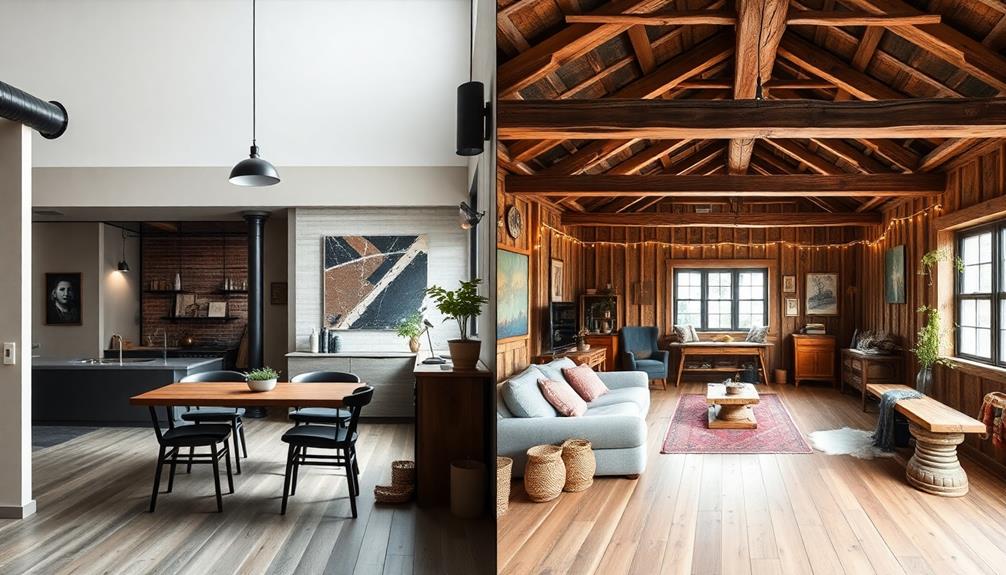
When it comes to architectural styles, you'll notice a clear contrast between traditional rural designs and modern urban aesthetics.
Urban spaces often prioritize sleek lines and contemporary materials, while rural interiors celebrate local craftsmanship and natural elements.
For instance, tropical villa plans often emphasize open spaces and natural light, creating a serene atmosphere that contrasts with the more compact designs found in urban settings.
As sustainability becomes more important, both styles are evolving, but they approach it in distinct ways that reflect their unique environments.
Traditional vs. Modern Designs
The charm of traditional rural interiors often lies in their handcrafted furnishings and locally sourced materials, which showcase a deep connection to the land and community values. In contrast, modern urban designs focus on sleek, minimalist aesthetics, utilizing high-tech materials and efficient space usage. Let's break down these differences:
| Aspect | Traditional Rural Interiors | Modern Urban Designs |
|---|---|---|
| Style | Handcrafted and rustic | Sleek and minimalist |
| Space Utilization | Larger, open spaces with natural light | Compact layouts with multifunctional furniture |
| Architectural Features | Exposed beams and stone walls | Open floor plans and smart technology |
In rural areas, the emphasis is on comfort and warmth, reflecting a slower-paced lifestyle. Conversely, urban interiors cater to fast-paced living, prioritizing convenience and accessibility. While traditional designs celebrate durability and functionality, modern trends often integrate sustainable practices like energy-efficient lighting and recycled materials. This contrast creates a unique identity for both rural and urban spaces, allowing you to choose a style that resonates with your lifestyle and values.
Material Sourcing Differences
Exploring material sourcing reveals significant contrasts between urban and rural interiors that shape their unique identities. In urban settings, you'll notice a reliance on modern construction materials like steel and glass, which reflect contemporary architectural trends. These materials often come from global sources, aligning with high-density living spaces and sleek, minimalist designs.
Additionally, urban interiors may incorporate elements of modern tropical aesthetics, blending indoor and outdoor environments through the use of natural materials. On the flip side, rural interiors frequently utilize traditional materials such as wood and stone, sourced locally. This not only emphasizes sustainability but also connects the interiors to the region's character and heritage.
The material sourcing differences also influence the overall style. Urban areas tend to adopt global trends, while rural environments showcase eclectic designs rooted in historical and cultural narratives.
Economic factors play a vital role, too. Urban developments often have larger budgets, allowing for premium materials that define luxury living. In contrast, rural constructions lean towards cost-effective options, prioritizing local craftsmanship and community heritage.
This divergence in material sourcing shapes how spaces feel and function, establishing a clear distinction between urban sophistication and rural authenticity.
Sustainability in Architecture
Sustainability in architecture is increasingly shaping both urban and rural designs, reflecting a growing awareness of environmental impacts. In urban areas, you'll find modern architectural styles that prioritize efficiency and space optimization. These designs often focus on high-density living and green building certifications. On the flip side, rural interiors incorporate traditional designs using locally sourced materials, promoting a connection to the landscape.
Here's a quick comparison of sustainability trends in urban and rural settings:
| Aspect | Urban Areas | Rural Areas |
|---|---|---|
| Design Focus | High-density living | Traditional and passive solar |
| Materials | Modern, often synthetic | Locally sourced natural materials |
| Green Spaces | Rooftop gardens, vertical farms | Agricultural practices, land stewardship |
Both environments face unique challenges. Urban interiors struggle with limited space for natural elements, leading to innovative solutions like biophilic design. Meanwhile, rural interiors benefit from larger gardens and outdoor living areas, fostering sustainability naturally. Movements like New Ruralism advocate for bridging the gap between these lifestyles, promoting innovative sustainable practices.
Community Dynamics and Social Spaces
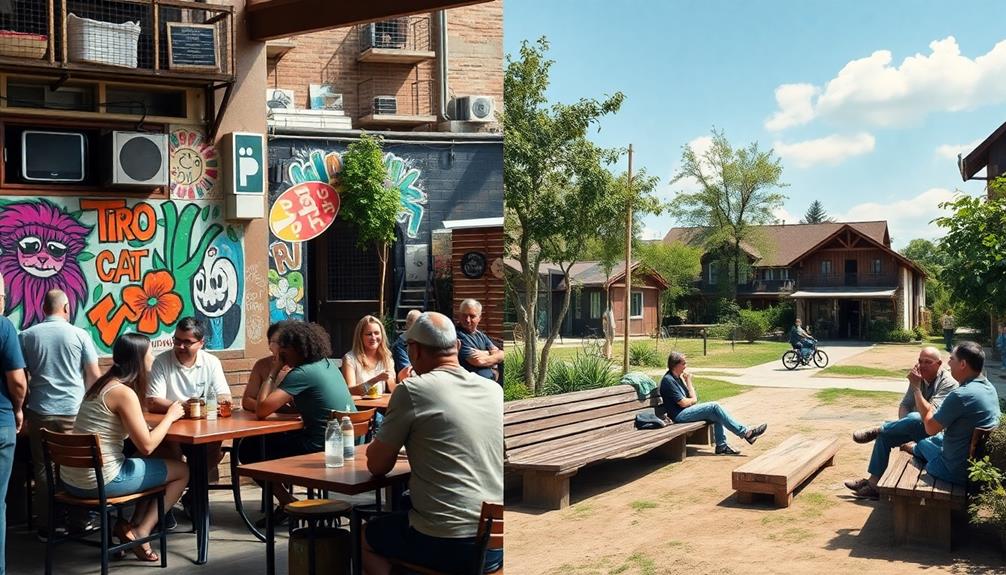
In many communities, the dynamics of social spaces reveal stark contrasts between urban and rural settings. In urban environments, you might find that social life often lacks those neighborly relationships. This reliance on virtual interactions can leave you feeling disconnected.
On the other hand, rural communities thrive on frequent face-to-face interactions, fostering strong ties among residents. This sense of connection is often reflected in the architecture of rural homes, which typically embrace a community-oriented layout that encourages social interaction, much like traditional Indonesian houses.
Rural areas typically boast mixed-use nodes like general stores and diners, which serve as community gathering spots. These venues enhance social interactions and enable information sharing, creating a sense of belonging.
While urban social gatherings may be limited to events like parties or holidays, you'll notice that rural residents engage in daily interactions that strengthen their community dynamics.
Even the hierarchical structure of rural paths supports coexistence among pedestrians and agricultural vehicles, promoting a shared sense of community. In contrast, the diverse and transient populations in urban settings can lead to a diminished sense of belonging.
Ultimately, rural communities often enjoy a greater sense of neighborly connections, resulting in increased community engagement compared to urban counterparts.
Infrastructure and Accessibility Issues
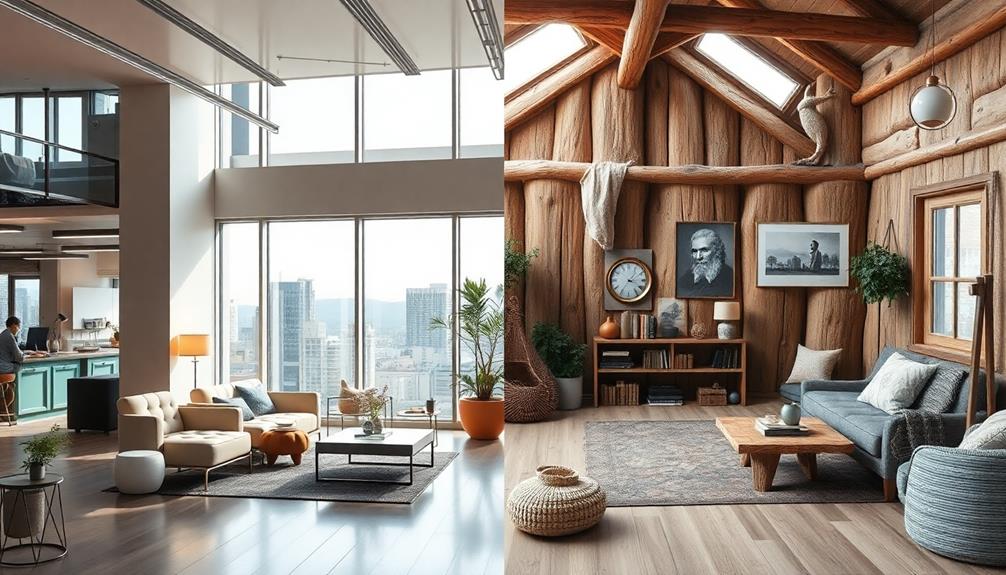
Infrastructure plays an essential role in shaping the accessibility of services and amenities in both urban and rural areas. In urban settings, advanced infrastructure, like extensive public transportation systems, makes it easier for you to navigate and access various services. You can hop on a bus or subway, reaching your destination without much hassle.
In contrast, rural areas often lack these options, forcing you to rely on personal vehicles, which limits your mobility and access. This difference in infrastructure can also be reflected in the local art and decor, such as the vibrant traditional artistry of Indonesian decor masks, which can enhance the aesthetic appeal of both urban and rural homes.
Highways and major roads act as crucial connections between urban and rural regions. While they facilitate access, they also contribute to the physical and social separation between the two. You might find that rural communities lack the defined infrastructure and mixed-use nodes typical in cities, making it harder to access essential services nearby.
Rural roads, designed to accommodate agricultural vehicles alongside pedestrians, illustrate different usage patterns. Social interactions in these areas often happen at crossroads or community gathering spots, creating a distinct character.
Meanwhile, urban areas promote diverse social engagement through a variety of public spaces and transit hubs, enhancing accessibility for everyone.
Environmental Considerations
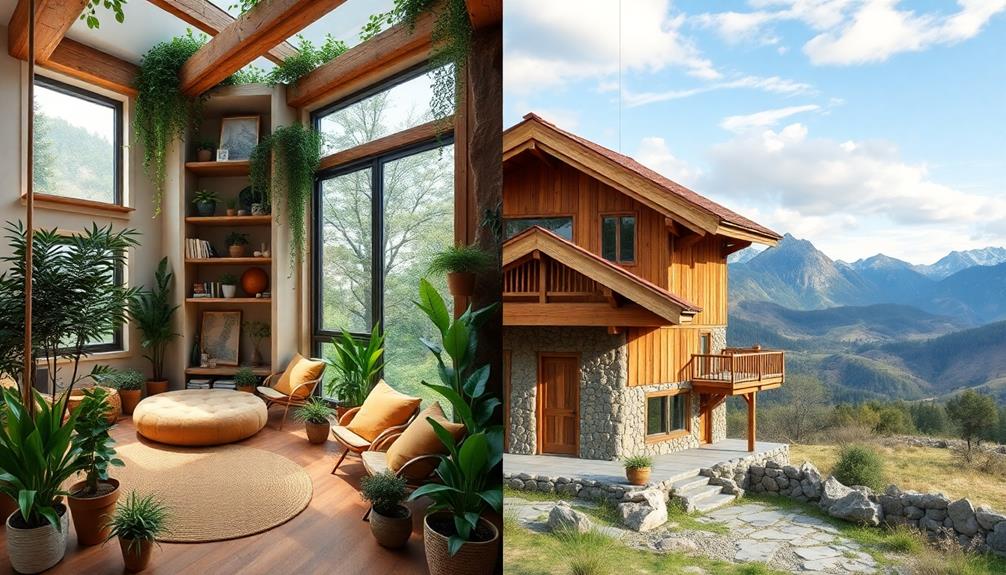
The environmental influences on urban and rural interiors are significant and often starkly contrasting. In urban areas, you deal with high levels of air, noise, and visual pollution caused by dense infrastructure and traffic. This pollution can negatively impact your health and well-being.
On the other hand, if you live in a rural home, you enjoy cleaner air and ample natural light due to fewer industrial activities and more open spaces. This promotes a healthier living environment that's hard to replicate in the city.
Urban settings often lack sufficient greenery, resulting in urban heat islands, while rural areas boast expansive natural landscapes that enhance biodiversity and ecological health.
You might also notice that urban housing relies heavily on modern construction materials and techniques, leading to higher energy consumption. In contrast, rural homes often embrace sustainability through traditional building methods and local materials.
Furthermore, rural housing fosters a connection to nature, allowing for larger gardens and outdoor spaces. In urban living, however, you typically find smaller spaces that prioritize convenience over environmental considerations.
This fundamental difference shapes how each environment influences your lifestyle and well-being.
Identity and Sense of Place
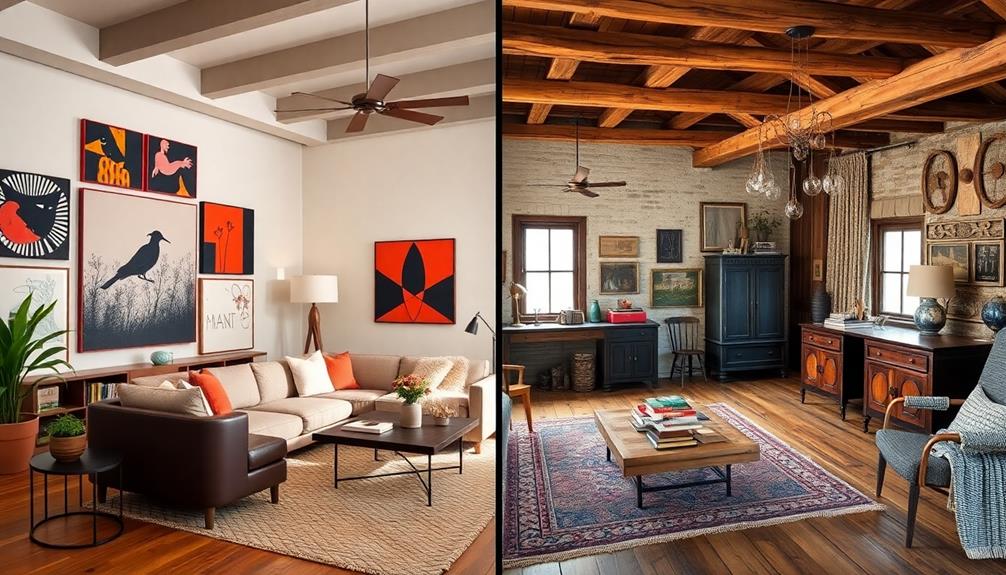
Identity and sense of place are deeply intertwined with your surroundings, shaping how you connect to your community and environment. In rural areas, you often develop a strong, evaluative place identity, fostering deep connections with both the land and your neighbors.
The hierarchical structure of rural paths and mixed-use nodes encourages regular social interactions, enhancing your sense of belonging and community ties.
In contrast, urban life, characterized by high population density and diverse cultures, can create a fragmented sense of identity. You might feel isolated or indifferent amidst the hustle and bustle, leading to a cognitive place identity that lacks depth.
Changes in your urban environment can feel impersonal, while rural residents often express a defensive stance against encroaching urban developments, reflecting their commitment to preserving cultural identity.
Age also plays a role in how you perceive your environment. Younger individuals often adapt differently to urban versus rural settings, impacting their values and sense of place.
Ultimately, your identity is shaped by the spaces you inhabit, influencing how you engage with the world around you, whether in the close-knit fabric of rural life or the vibrant tapestry of urban living.
Future Trends in Interior Design
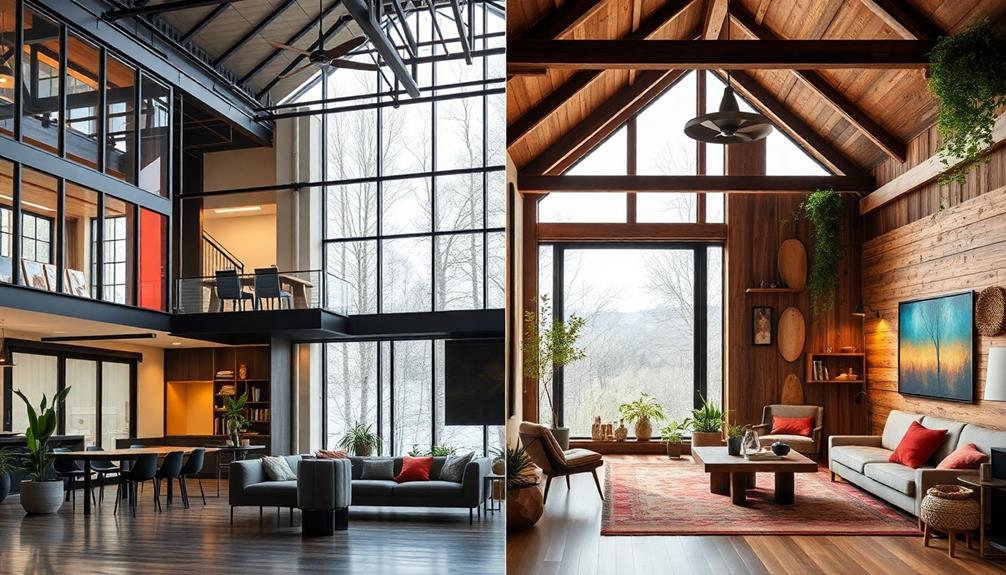
Sustainability is reshaping the landscape of interior design, driving innovations that cater to both urban and rural environments. You'll notice a strong focus on sustainable materials and energy-efficient solutions, reflecting a growing awareness of environmental impact.
In urban interiors, smart home technology is on the rise, enhancing convenience with automated lighting and climate control systems that promote energy efficiency.
Meanwhile, rural interiors are embracing biophilic design principles, creating spaces that connect you to nature and highlight the surrounding landscapes. As remote work continues to evolve, rural designs are adapting to include multifunctional spaces, seamlessly blending home offices with living areas.
Urban interior design trends lean toward minimalist aesthetics, maximizing small living spaces with multifunctional furniture. On the other hand, rural designs often favor traditional, spacious layouts that encourage communal living and social interaction.
These trends not only reflect current lifestyle changes but also cater to the unique needs of urban and rural interiors, ensuring that your living spaces are both functional and environmentally conscious.
As you consider your own interior design choices, think about how these trends can enhance your environment and align with your values.
Frequently Asked Questions
Why Is There a Lot of Difference Between Urban and Rural Area?
You'll notice significant differences between urban and rural areas due to factors like population density, economic opportunities, social dynamics, environmental conditions, and transportation options. Each setting shapes lifestyles and accessibility in unique ways.
How Are Rural and Urban Settings Different?
You'll notice rural and urban settings differ markedly. Urban areas buzz with modern life and amenities while rural spaces offer tranquility and community. Your lifestyle choices reflect these contrasting environments, shaping your daily experiences and interactions.
What Is the Most Appropriate Factor Used to Differentiate Between Rural and Urban Areas?
You'll find that the most appropriate factor to differentiate between rural and urban areas is population density. Urban areas boast high density, while rural regions are characterized by lower density and more open spaces.
Why Are Urban Areas More Diverse?
Urban areas brim with bustling backgrounds, attracting ambitious individuals seeking jobs and journeys. This melting pot of multicultural minds creates diverse dynamics, fostering friendships and facilitating interactions that enrich your experience in vibrant city life.
Conclusion
So, whether you're sipping artisanal coffee in a sleek urban loft or lounging in a rustic farmhouse with a questionable collection of animal heads, remember: design isn't just about aesthetics; it's a reflection of who we are—or at least who we pretend to be. As cities grow and rural areas cling to charm, the interiors will keep evolving. Who knows? Maybe one day you'll find a hipster café in a barn, serving kale smoothies with a side of irony.
Home Decor
Understanding Urban vs. Rural Design Styles
Keen insights into urban and rural design styles reveal intriguing contrasts that shape our environments and identities—what differences truly define these spaces?
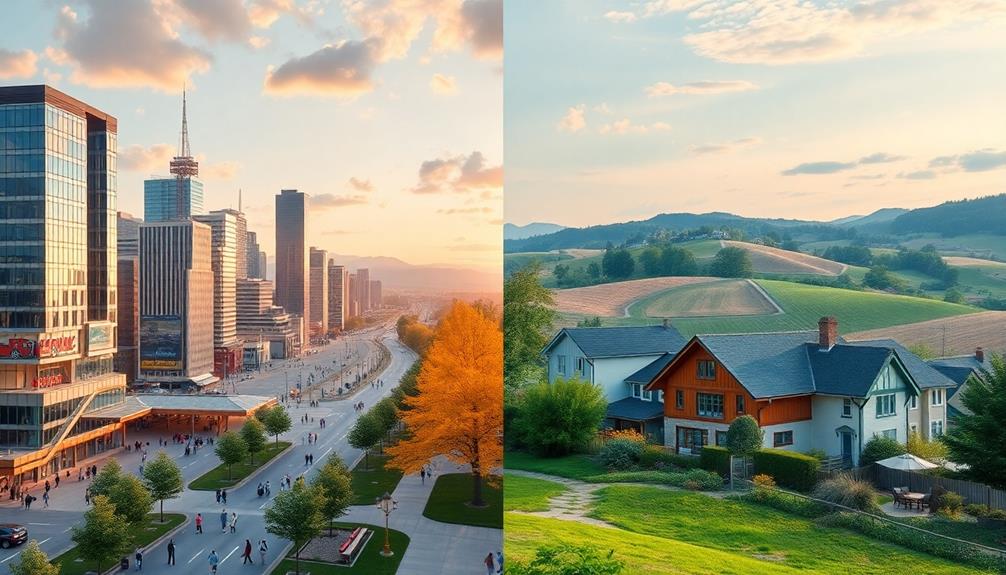
Understanding urban versus rural design styles involves recognizing their unique characteristics. In urban areas, you'll find high-density living and multi-story structures, reflecting a need for space and convenience. Rural design, on the other hand, emphasizes simplicity and harmony with nature, often using natural materials. The infrastructure also differs; urban settings boast extensive public transport, while rural areas rely on personal vehicles. Community engagement plays a significant role in both, shaping designs that reflect local culture and needs. Explore these contrasts further to uncover how they impact our living environments and contribute to identity.
Key Takeaways
- Urban design emphasizes high-density living with multi-story structures, while rural design focuses on simplicity and harmony with natural landscapes.
- Urban areas offer diverse building types catering to various economic segments, whereas rural markets primarily feature detached homes.
- Urban architecture incorporates advanced infrastructure and public transport, contrasting with rural reliance on personal vehicles and limited transport options.
- Community amenities in urban settings enhance daily living, while rural areas often require personal vehicles for basic services and access.
- Urban life promotes economic opportunities and cultural expression, while rural life fosters strong community ties and a closer connection to nature.
Urbanization Trends Impacting Design
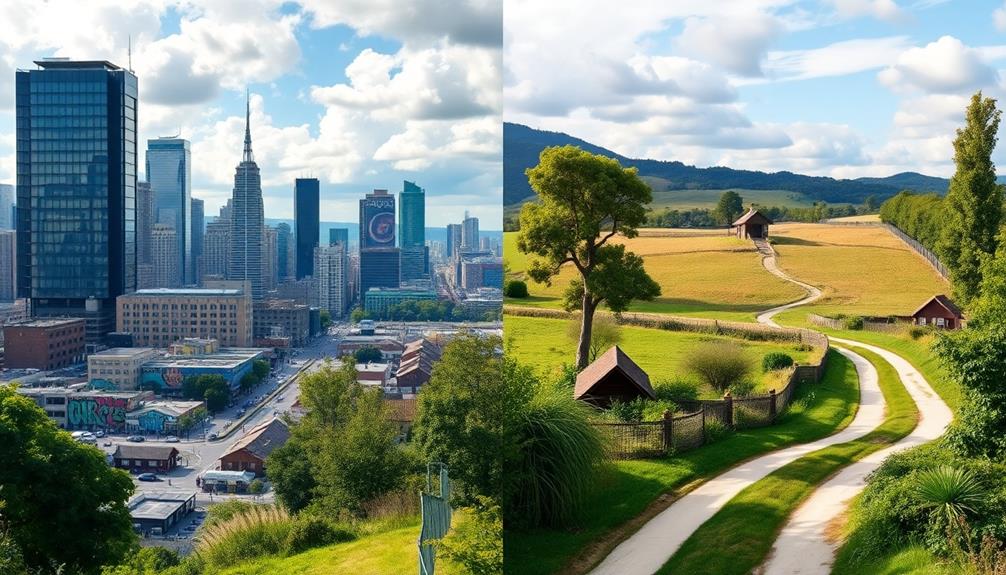
As urbanization continues to reshape our world, it's clear that the design of our cities must evolve to meet the needs of growing populations. With projections indicating an increase of 2.5 billion people by 2050, urban development that sprawls becomes a pressing concern.
In the U.S. alone, an additional 100 million people are expected to live in urban areas, highlighting the urgent need for innovative urban planning strategies. The challenge is further complicated by the diverse architectural styles found in regions like Indonesia, where traditional and modern elements coexist, reflecting cultural heritage and environmental considerations traditional and modern housing.
You're facing challenges that stem from the shift from rural to urban living, where effective urban design must bridge these two environments. Integrated urban-rural planning is essential to manage the peri-urban landscapes that emerge as cities expand. This approach helps preserve crucial agricultural land while accommodating urban growth.
In Australia, the anticipated population increase of over 13 million further intensifies the demand for sustainable practices in urban development. You've got to balance growth with environmental concerns, ensuring that new designs promote livability, accessibility, and sustainability.
Key Differences in Architectural Styles
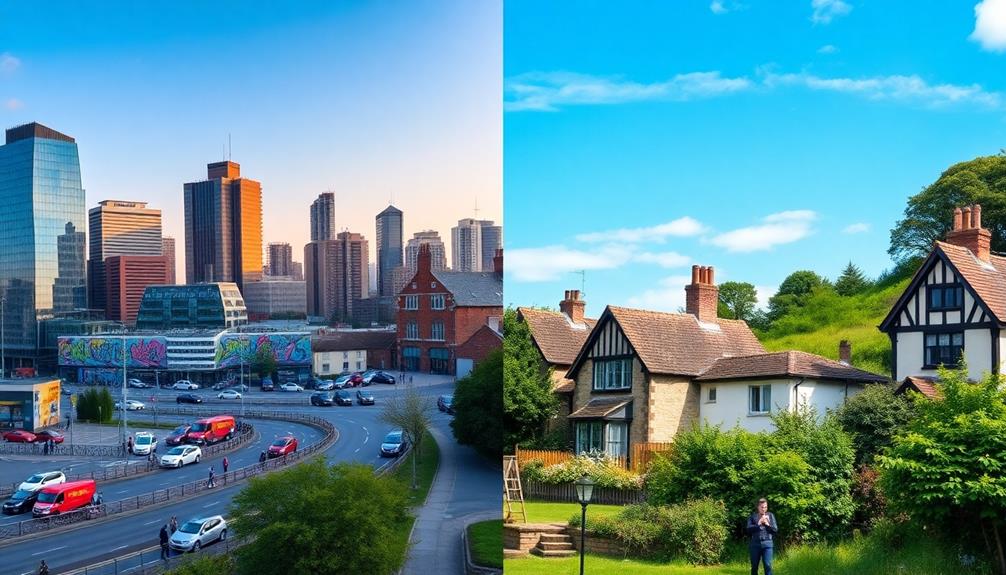
Urban and rural architectural styles reflect distinct philosophies shaped by their environments, needs, and cultural contexts. Urban architecture showcases intricate facades and high-density living, focusing on multi-story structures like apartments and skyscrapers. In contrast, rural architecture emphasizes simplicity and harmony with the natural landscape, often featuring single-family homes and farms that blend seamlessly with open spaces.
Importantly, modern tropical aesthetics in Bali exemplify how urban designs can incorporate natural materials and greenery to enhance livability, creating a balance between built and natural environments an emphasis on sustainability.
When you consider housing markets, urban areas typically offer a diverse range of building types, including condos and townhouses. Rural housing, however, leans towards detached homes and agricultural structures, designed to promote a connection with nature. This difference impacts the environmental footprint; urban architecture can lead to higher pollution levels and urban heat islands, while rural architecture fosters biodiversity and integrates green spaces more effectively.
Additionally, economic factors play a role—urban housing markets experience rapid price fluctuations and higher property values driven by demand, whereas rural markets grow more slowly, maintaining stable pricing. Understanding these key differences helps you appreciate how architectural styles not only reflect aesthetic choices but also respond to the unique challenges and opportunities of their respective environments.
Infrastructure in Urban vs. Rural Areas
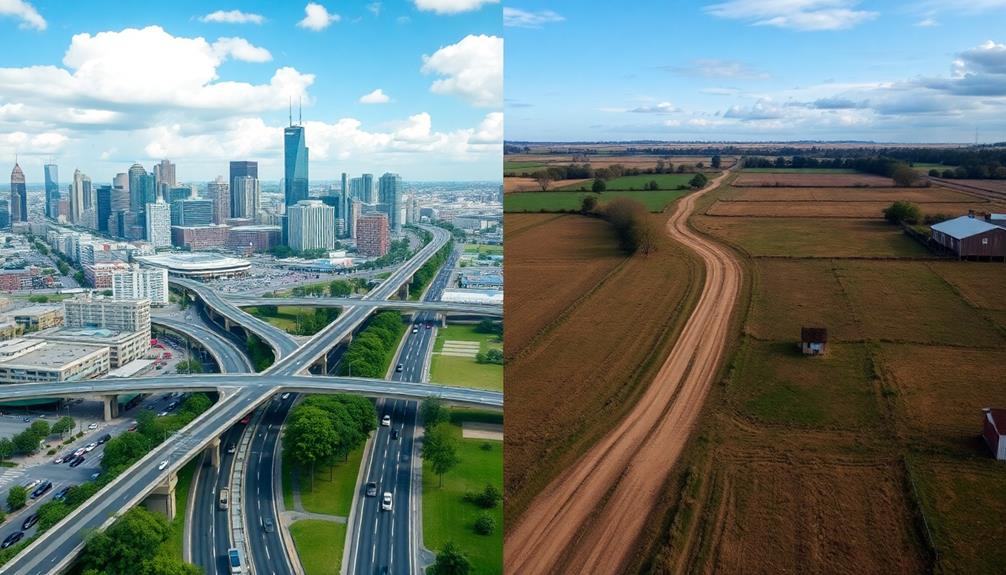
When you think about infrastructure, urban and rural areas show marked differences in how they function.
In cities, you often find extensive public transport and a variety of amenities, while rural areas rely more on personal vehicles and may have limited services.
Traditional Indonesian housing, for instance, often reflects regional identity and utilizes local materials, which can impact infrastructure requirements in those areas traditional housing styles.
This contrast raises important questions about the accessibility and maintenance of infrastructure in different settings.
Public Transport Accessibility Differences
Maneuvering the differences in public transport accessibility reveals stark contrasts between urban and rural areas.
In urban areas, you'll find extensive public transport options like buses, subways, and light rail that enhance connectivity and reduce the need for personal vehicles. This system is designed for high population densities, offering frequent service and shorter wait times, which notably boosts mobility and access for residents. Additionally, urban areas often integrate sustainable architecture into their planning, further promoting efficient transport solutions.
On the other hand, rural residents often face a different reality. About 45% of them live in regions where public transportation isn't available, forcing reliance on personal vehicles for commuting. This lack of options can severely limit their mobility and access to essential services, making daily life more challenging. In fact, rural transport services tend to be infrequent and may not operate during weekends or holidays.
The environmental impact of transportation is also significant. Urban public transport systems can considerably reduce greenhouse gas emissions per capita compared to the higher car dependency prevalent in rural regions.
Infrastructure Maintenance Challenges
In recent years, maintaining infrastructure has become a pressing challenge for both urban and rural areas, each facing unique obstacles. Urban infrastructure demands significant funding, with cities allocating billions for road repairs and utility upgrades. In contrast, rural areas often grapple with budget constraints, leading to slower maintenance response times.
Urban regions benefit from advanced technology for monitoring infrastructure health, while rural areas may lack these innovations, complicating maintenance efforts. The high population density in cities creates more wear and tear, necessitating frequent repairs. Conversely, rural infrastructure, characterized by longer stretches of road, can be costly to maintain due to geographic spread and lower population density.
Here's a summary of some of the key differences:
| Aspect | Urban Areas | Rural Areas |
|---|---|---|
| Funding | Significant, billions allocated | Budget constraints |
| Technology | Advanced monitoring systems | Limited access |
| Wear and Tear | Higher due to density | Lower usage |
| Maintenance Response Time | Quicker due to funding | Slower, longer response times |
| Infrastructure Length | Shorter, more concentrated | Longer stretches, more costly |
These maintenance challenges highlight the disparities in infrastructure development between urban and rural areas.
Community Amenities Availability
Urban areas buzz with life, offering a wealth of community amenities that make daily living convenient and enjoyable. From extensive public transportation systems to a plethora of shopping, dining, and entertainment options, you'll find that accessibility is a significant advantage in cities.
This urban perspective showcases how easy it's for you to commute and access essential services, unlike in rural areas, where public transport is often scarce and personal vehicles are a necessity. Additionally, the vibrant art decor found in urban settings can enhance community spaces, celebrating local culture and creativity, making each neighborhood unique and inviting.
Indonesian art decor adds to the charm of urban life, turning public spaces into galleries of cultural expression.
When it comes to healthcare facilities, urban settings excel by providing a wider range of services, making medical care more accessible. In contrast, rural regions can leave you with limited options and longer travel times for healthcare needs.
While urban living offers many conveniences, it's crucial to recognize that the density can lead to higher pollution levels and congestion.
Rural areas, however, promote biodiversity and boast more green spaces, which contribute to a healthier environment. Although economic opportunities may be slower-growing in rural regions, the charm of community-oriented living can still be appealing.
Ultimately, your choice between urban and rural life will hinge on what community amenities matter most to you.
Community Dynamics and Engagement
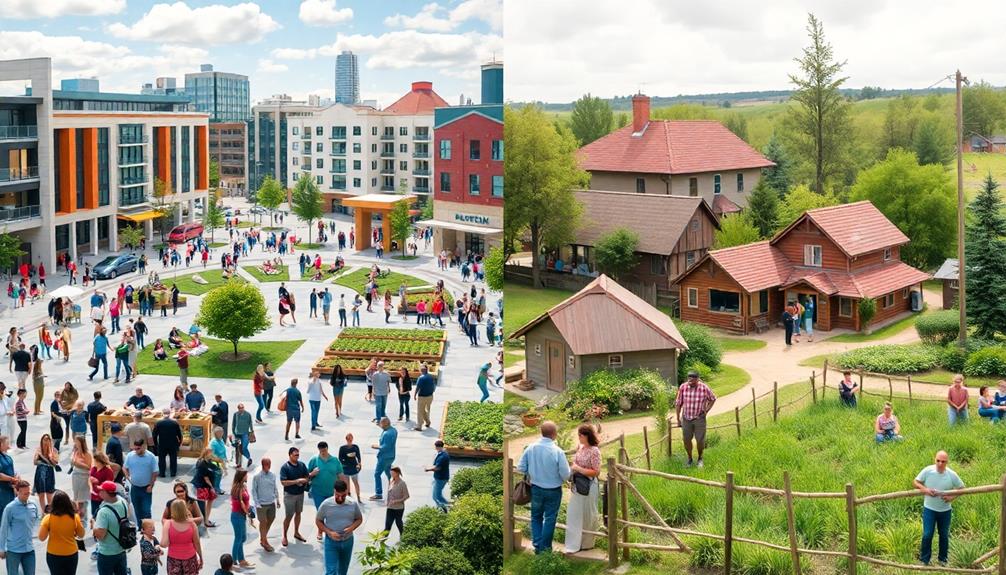
When you get involved in community participation strategies, you help shape the future of your neighborhood.
By preserving local identity, you guarantee that design solutions resonate with the values and culture of your community, much like how Indonesian decor masks reflect rich cultural heritage through their intricate designs.
This collaborative approach not only strengthens connections among residents but also fosters a sense of pride and belonging.
Community Participation Strategies
Engagement is at the heart of effective community participation strategies, driving sustainable design that truly reflects local values. When you actively involve community members in the design process, you create solutions that resonate with their needs and aspirations.
For instance, incorporating elements from local culture and traditions, such as Indonesian wedding decor ideas, can enhance community involvement and pride. Community engagement fosters a sense of ownership; residents feel more inclined to support urban development initiatives that align with their preferences.
To tap into diverse rural perspectives and guarantee inclusivity, you can implement strategies like workshops, surveys, and participatory design sessions. These methods not only gather valuable feedback but also encourage collaboration among all community members, including marginalized groups.
Local Identity Preservation
Often, communities face the challenge of balancing growth with the need to preserve their unique identities. Local identity preservation is essential, especially in rural areas where urban encroachment threatens traditional values and agricultural fabric.
To achieve this balance, you can focus on the following strategies:
- Community Engagement: Involve residents in the design process to guarantee their values and needs are prioritized. This fosters a sense of ownership and relevance in projects. Additionally, incorporating local artistry, such as traditional artistry, can enhance the community's cultural representation in design.
- Rural Perspectives to Shape Design: Incorporate the insights and experiences of local residents to create spaces that resonate with community heritage.
- Integrated Urban-Rural Planning: Develop plans that address urban expansion while preserving rural landscapes, promoting economic resiliency and social connections.
- Articulate the Design Process: Architects and planners should clearly communicate their vision to the community, encouraging collaboration and understanding.
Challenges Faced by Rural Communities
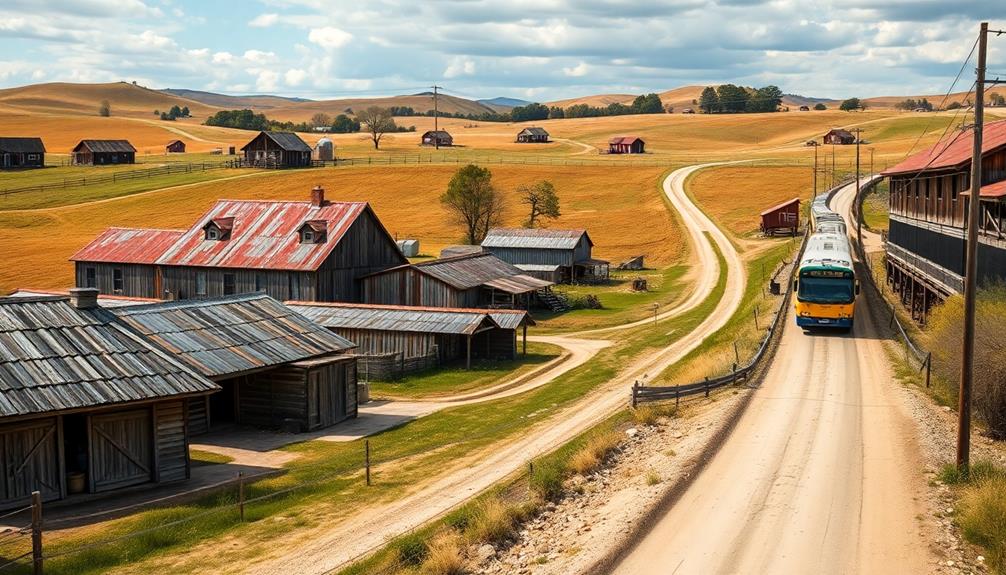
In rural communities, residents grapple with significant challenges that hinder their development and prosperity. Education and employment crises are prevalent, as traditional values sometimes restrict younger generations from adapting to modern economic demands.
When urban development encroaches on rural areas, it can lead to a feeling of cultural loss, with residents perceiving their heritage as being invaded by outside influences. The emphasis on maintaining a connection to nature and sustainable practices, as seen in Balinese design characteristics, can serve as a model for integrating traditional values with modern needs.
Young individuals in these settings often struggle to apply agricultural principles to contemporary contexts, facing a tension between preserving traditional practices and embracing innovation. This defensive stance against change can stall progress, making it tough to implement sustainable solutions that address evolving community needs.
For instance, as landscapes and building types change, the essence of rural identity shifts, impacting residents' sense of belonging.
To foster growth, it's essential for rural communities to find a balance between maintaining their traditional values and welcoming necessary changes. By doing so, they can create an environment where sustainable solutions thrive, ensuring that their unique cultural identity remains intact while adapting to the demands of a modern world.
Future Directions for Urban-Rural Integration
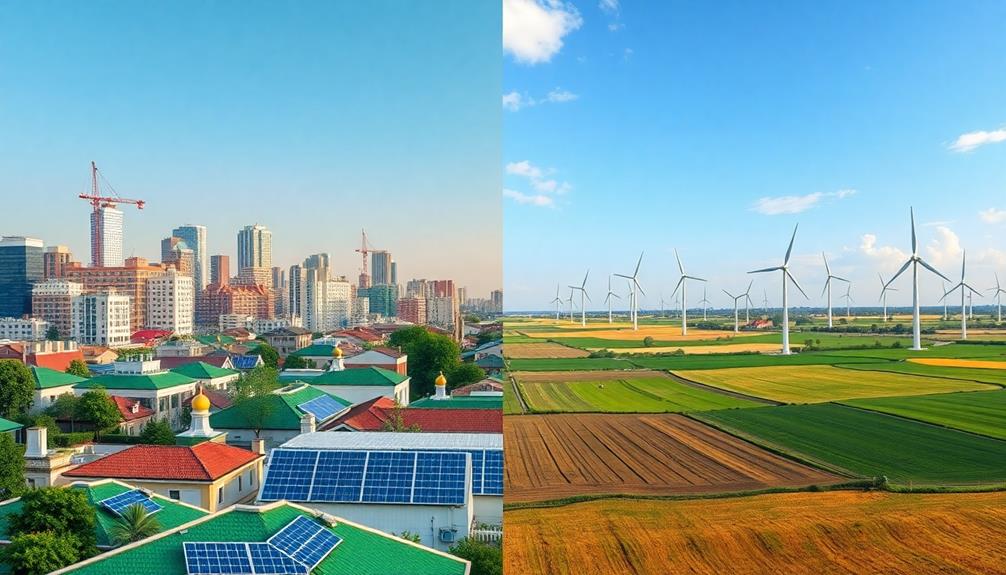
Urban-rural integration is essential for fostering cohesive communities that thrive on their interdependencies. As you navigate the future of community design, consider how urban and rural perspectives can merge to create vibrant spaces.
By incorporating traditional Indonesian style home decor or modern tropical architecture concepts, communities can reflect their unique cultural identities while enhancing the aesthetic appeal of their environments.
Here are four directions to explore for effective integration:
- Integrated Planning: Develop policies that encourage collaboration between urban and rural stakeholders, guaranteeing that both regions benefit from shared resources and infrastructure.
- Innovative Design Practices: Embrace architectural solutions that reflect local identities while addressing the unique needs of both urban and rural areas. This can enhance community resilience and cultural appreciation.
- Sustainable Design Practices: Prioritize sustainable approaches that actively involve community members in the planning process. This guarantees that development meets the ecological and social needs of all residents.
- Connectivity Initiatives: Create projects that bridge the physical and social gaps between urban and rural communities, reducing suburban sprawl and promoting a cohesive landscape.
The Role of Natural Materials
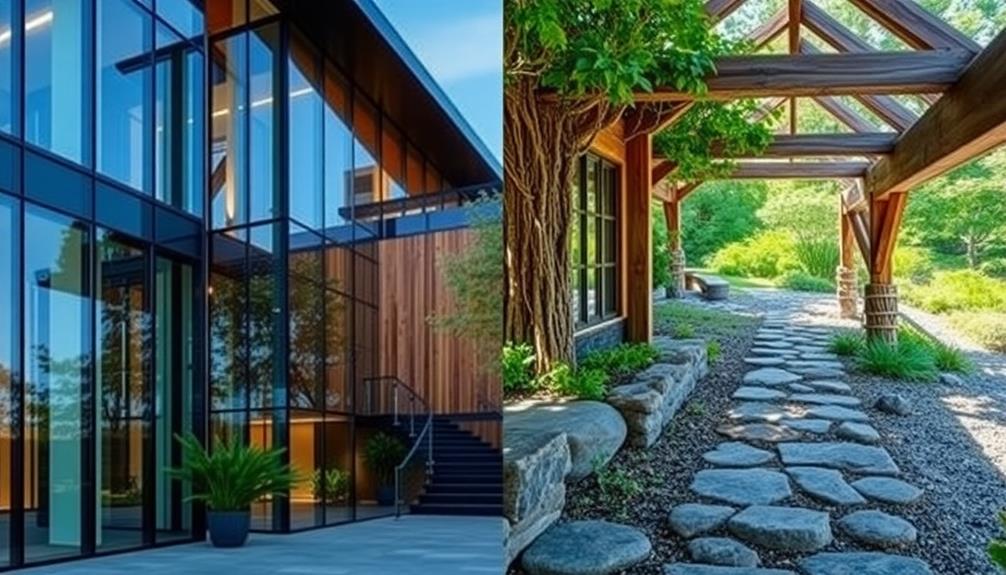
As communities seek to integrate urban and rural design styles, the choice of materials plays a vital role in shaping their identity. In rural design, natural materials like wood, stone, and clay are prioritized to create structures that harmonize with natural surroundings. These materials not only enhance the aesthetic appeal but also promote sustainability by minimizing environmental impact.
By using locally sourced natural materials, rural architecture maintains a strong connection to cultural heritage, reflecting local traditions and histories.
In contrast, urban design often opts for industrial materials such as steel and concrete, which can create a disconnect from the surrounding environment and local ecosystems. This divergence can lead to urban spaces that feel sterile and uninspired.
By choosing natural materials in rural settings, you foster community identity and resilience, connecting inhabitants to their historical and cultural narratives through architecture.
Ultimately, the role of natural materials is essential in bridging the gap between urban and rural design. By emphasizing sustainability and cultural heritage, you can create spaces that resonate with both the past and the future, enriching the lives of those who inhabit them.
The Influence of Design Methodologies
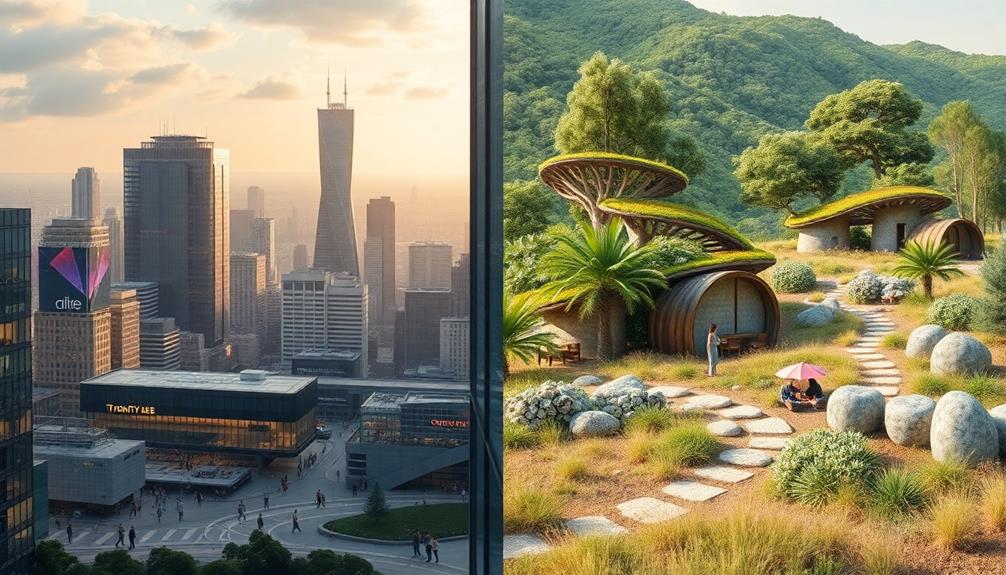
Design methodologies play a vital role in shaping how communities approach the integration of urban and rural aesthetics. When you consider the distinct needs of rural and urban areas, effective design methodologies can drive innovation and enhance community involvement.
Here are four key aspects to keep in mind:
- Community Engagement: In rural design, involving local populations guarantees that solutions align with community values, fostering a sense of ownership.
- Holistic Solutions: Design thinking encourages collaboration across disciplines, creating approaches that connect human and natural systems effectively.
- Sustainability Focus: Rural design methodologies prioritize resilience, addressing critical issues like climate change and food security while preserving cultural heritage.
- Architects as Bridges: Architects play a vital role in linking scientific research and practical applications, helping to improve social, economic, and environmental conditions in rural settings.
Frequently Asked Questions
How Can You Tell the Difference Between Urban and Rural?
You can tell the difference between urban and rural by observing population density, types of housing, transportation options, and social dynamics. Urban areas are bustling and diverse, while rural regions feel quieter and more close-knit.
What Is Urban and Rural Life Style?
Imagine bustling streets filled with energy versus quiet country roads lined with fields. Urban life's fast-paced, vibrant, and full of amenities, while rural life's slower, serene, and embraces nature, offering community and tranquility you can't find in cities.
How Do You Know if a Place Is Rural or Urban?
You can tell if a place is rural or urban by observing the population density, infrastructure, and amenities. Urban areas have dense buildings and services, while rural places feature open spaces and fewer facilities.
What Is Rural Versus Urban Mindset?
You notice a rural mindset values community ties and tradition, while an urban mindset thrives on innovation and diversity. Each perspective shapes how you interact with your environment and influences your daily life choices.
Conclusion
In understanding urban and rural design styles, you see how each space tells its own story, shaped by trends and community needs. As you navigate these landscapes, remember that blending their unique qualities can create vibrant, harmonious environments. Embrace the challenge of integrating natural materials and innovative methodologies, where every brick and beam reflects the spirit of the people. By fostering connections between urban and rural areas, you're not just building structures; you're crafting a tapestry of life.
Home Decor
10 Best Differences in Urban and Rural Interiors
Journey through the intriguing contrasts of urban and rural interiors, where design choices reveal deeper lifestyle secrets that are waiting to be uncovered.
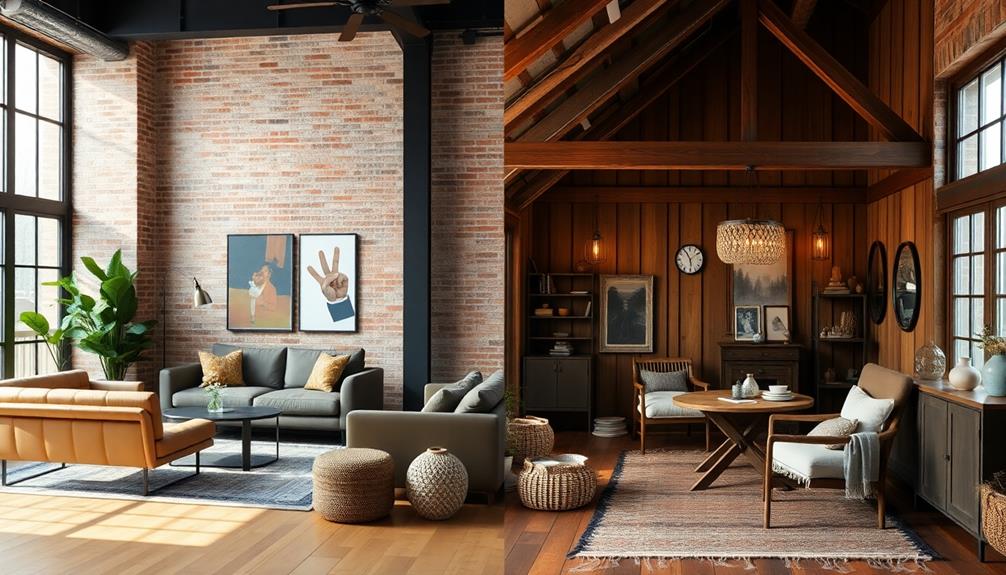
Urban and rural interiors differ greatly, reflecting their environments and lifestyles. In urban areas, you'll find sleek, minimalist designs with synthetic materials, while rural homes embrace warmth with natural elements like wood. Color palettes contrast too; urban spaces often use bold monochromatics, whereas rural settings favor earth tones. Space utilization varies; urban designs maximize vertical space with multifunctional furniture, but rural layouts allow for larger, standalone pieces. While urban areas prioritize practicality and efficiency, rural interiors celebrate personalization and cozy atmospheres. Explore further to uncover more fascinating distinctions between urban and rural interior designs.
Key Takeaways
- Urban interiors favor sleek, modern aesthetics with minimalism, while rural interiors embrace warmth, coziness, and eclectic styles reflecting nature.
- Material choices in urban settings prioritize durability with synthetic materials, whereas rural designs celebrate local, eco-friendly materials like wood and bamboo.
- Space utilization in urban homes emphasizes vertical optimization and multi-functional furniture, contrasting with rural designs that allow for larger, standalone pieces and open layouts.
- Urban color palettes lean towards monochromatic schemes with bold tones, while rural spaces utilize earth tones and vibrant colors that harmonize with the landscape.
- Urban lighting creates a vibrant ambiance through large windows, while rural interiors focus on warm, soft lighting to foster comfort and intimacy.
Design Philosophy Contrast
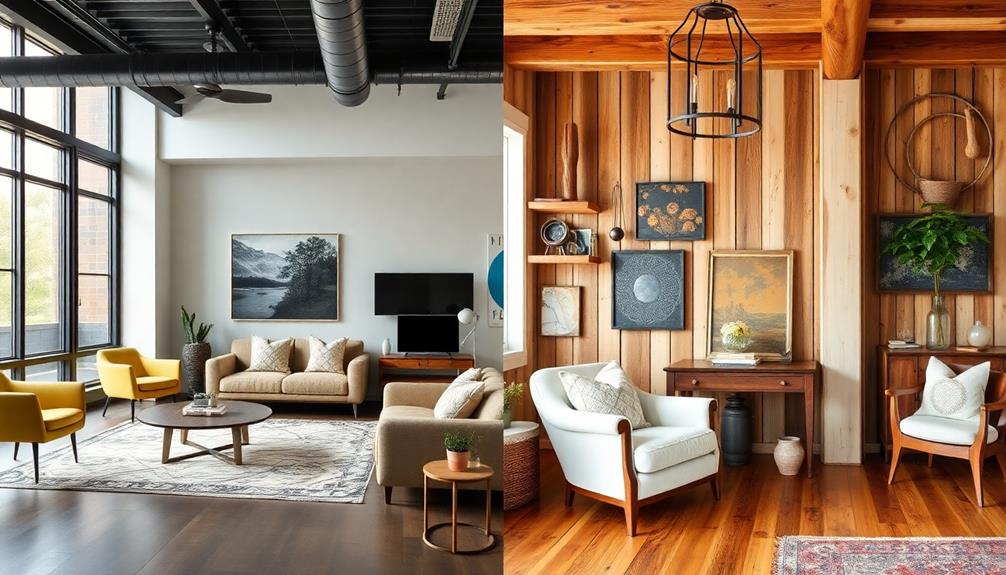
When you step into an urban interior, you're met with a sleek, modern aesthetic that prioritizes minimalism and functionality. Urban designs often feature clean lines and monochromatic color palettes, creating a sense of order in high-density living environments. Here, every piece of furniture serves multiple purposes, maximizing space efficiency in often compact areas.
You'll notice how open spaces are utilized to foster light and airiness, making the most of limited square footage. In contrast, Balinese interior design concepts emphasize natural materials like wood and stone, creating a harmonious environment that can also be found in rural settings, where warmth and comfort are key natural materials.
In contrast, rural interiors embrace a different design philosophy. They focus on warmth and coziness, often incorporating wooden furniture that reflects local craftsmanship and tradition. These spaces celebrate natural materials like wood and stone, creating an inviting atmosphere.
You find large windows that open up to breathtaking views, inviting nature indoors and enhancing the connection with the outdoors.
While urban settings lean toward high-tech innovations and smart home features, rural designs prioritize sustainability and comfort. This contrast highlights how urban and rural interiors cater to different lifestyles and philosophies, each with its unique charm and appeal.
Whether you prefer the sleekness of urban design or the warmth of rural aesthetics, both create spaces that resonate with their surroundings.
Material Choices
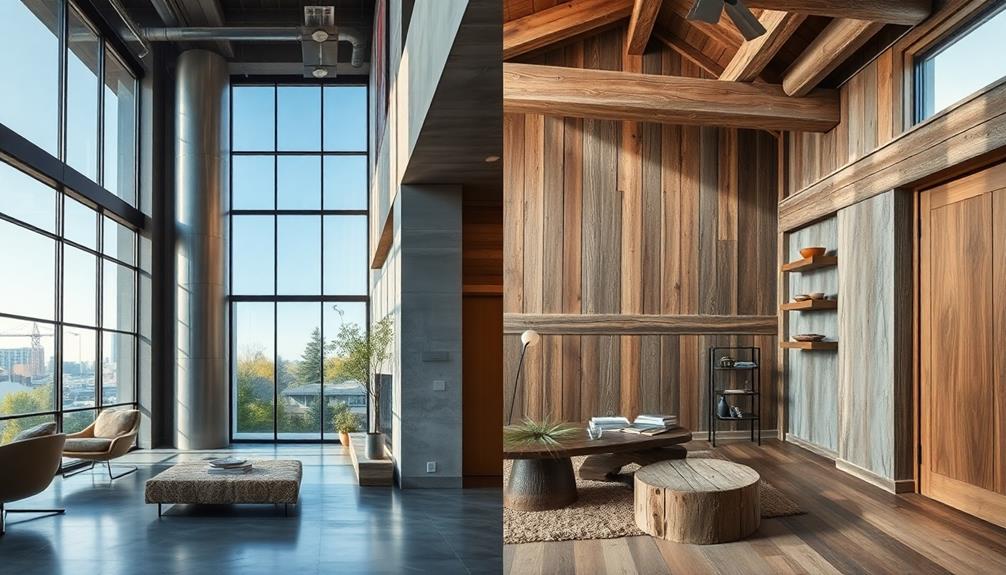
When choosing materials for your space, consider the contrast between natural and synthetic options.
Urban settings often lean towards sleek, synthetic materials for a modern look, while rural interiors embrace the warmth of natural textures. This choice impacts not just aesthetics but also how comfortable and durable your environment feels.
In rural areas, the use of local materials like wood and bamboo not only enhances the design but also reflects the cultural significance of traditional housing styles, such as Rumah Adat.
Natural vs. Synthetic Materials
Material choices in interior design reveal a stark contrast between urban and rural aesthetics, particularly in the use of natural versus synthetic materials. In urban environments, you'll often find a preference for synthetic materials like engineered wood, vinyl, and polyester. These options are celebrated for their durability and low maintenance, allowing you to achieve a modern look with minimal effort.
Urban designs frequently incorporate high-tech innovations, such as antimicrobial finishes, which aren't as common in rural settings. However, many urban interiors are also starting to embrace elements of traditional craftsmanship, such as handcrafted decorative pillows that reflect cultural heritage and add a unique touch to the modern design landscape, showcasing the appeal of Indonesian decorative pillows.
On the other hand, rural interiors focus on natural materials like solid wood, cotton, and linen, emphasizing warmth and authenticity. When you step into a rural home, you'll appreciate the craftsmanship and sustainability that come from using locally sourced materials. This choice not only enhances the aesthetic but also promotes eco-friendliness by utilizing renewable resources.
Moreover, rural designs often reflect traditional practices and historical influences, creating a personalized atmosphere. In contrast, urban spaces may feel more mass-produced, leading to a less unique environment.
This distinction in material choices highlights how urban and rural spaces cater to different values and lifestyles.
Durability Versus Comfort Focus
Urban interiors often emphasize durability in their material choices, catering to the demands of high-traffic environments. You'll find materials like steel and concrete that withstand wear and tear, reflecting a modern style that prioritizes longevity.
The sleek finishes often seen in urban settings not only enhance aesthetics but also support sustainability through high-performance materials like acrylic and fiberglass. Urban designs may also incorporate elements inspired by Bali interior design ideas, bringing vibrant colors and local crafts into the mix.
In contrast, rural interiors tend to focus on comfort, using softer materials such as wood and natural textiles. This style prioritizes coziness and warmth, often incorporating a color palette that reflects the surrounding landscape.
Craftsmanship shines in these spaces, where rustic charm is essential and layered textiles invite relaxation.
While urban designs may lean toward functional elements, rural spaces celebrate comfort with softer furnishings. You might notice that urban interiors often sacrifice some comfort for the sake of durability, whereas rural interiors create inviting atmospheres that encourage leisure.
Ultimately, the choice between urban and rural materials reflects a balance of durability versus comfort, shaping the way you experience these distinct environments.
Texture and Aesthetic Appeal
In contemporary design, texture and aesthetic appeal play essential roles in defining the character of both urban and rural interiors. When you step into an urban space, you'll notice sleek materials like glass, metal, and polished concrete that create a striking industrial vibe.
Minimalist design often means fewer, high-quality materials, emphasizing a clean and modern aesthetic. You might find bold color contrasts and geometric patterns that reflect contemporary art influences. In contrast, luxury tropical design aesthetics often showcase a blend of natural elements with modern luxury, enhancing the urban experience with unique textures and finishes.
In contrast, rural interiors invite you to experience warmth and comfort through natural materials like wood, stone, and textiles. Here, the mix of textures and layered materials enhances that cozy, lived-in feel.
You'll appreciate the organic essence of cotton, linen, and wool, as these natural fibers provide both durability and charm. The muted, earthy tones and floral patterns evoke a connection to nature and tradition.
While urban interiors might incorporate high-tech finishes and smart home technologies, rural spaces celebrate handcrafted and artisanal materials that reflect local craftsmanship.
Ultimately, the choice of materials greatly impacts the aesthetic appeal, shaping your experience of both environments.
Color Palettes
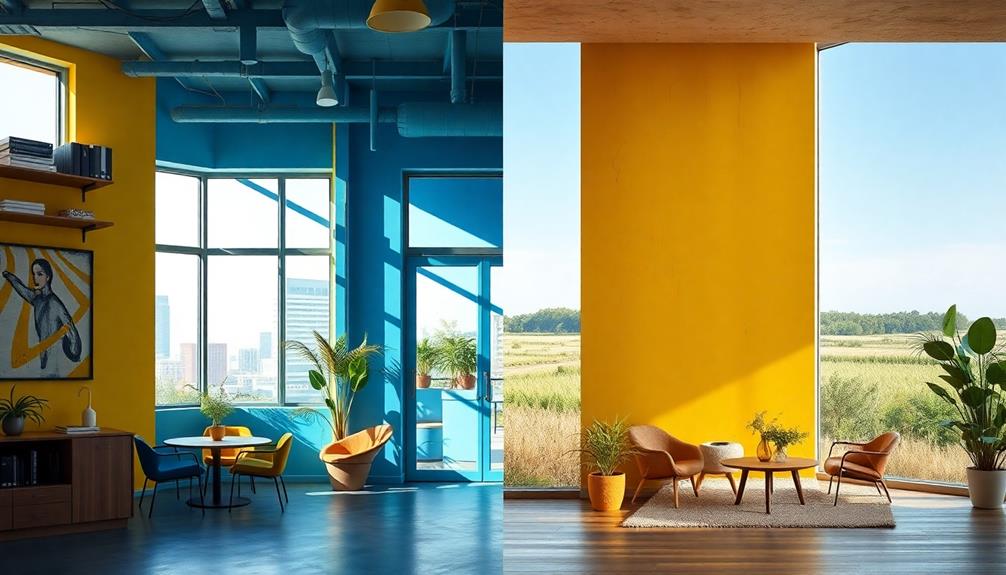
Exploring color palettes reveals a striking contrast between urban and rural interiors. In urban settings, you'll notice a preference for monochromatic schemes featuring deep, bold tones. These colors convey sophistication and modernity, emphasizing clean lines and minimalism. On the other hand, rural interiors embrace lighter, airy hues like whites, beiges, and soft blues, creating a warm and inviting atmosphere.
Here's a quick comparison to highlight these differences:
| Urban Interiors | Rural Interiors |
|---|---|
| Monochromatic schemes | Light, airy colors |
| Deep, bold tones | Earth tones, pastels |
| High-contrast palettes | Harmonious blends |
| Consistent year-round | Seasonal shifts |
| Emphasis on modernity | Focus on coziness |
This contrast not only reflects aesthetic preferences but also lifestyle choices. Urban designs often showcase sleek sophistication, while rural spaces aim for a cozy, natural feel. For instance, while Western interior design might lean into darker hues for a rustic vibe, traditional country design will opt for cheerful accents that brighten up the space. Each palette captures the essence of its environment, making your choice all the more impactful.
Space Utilization
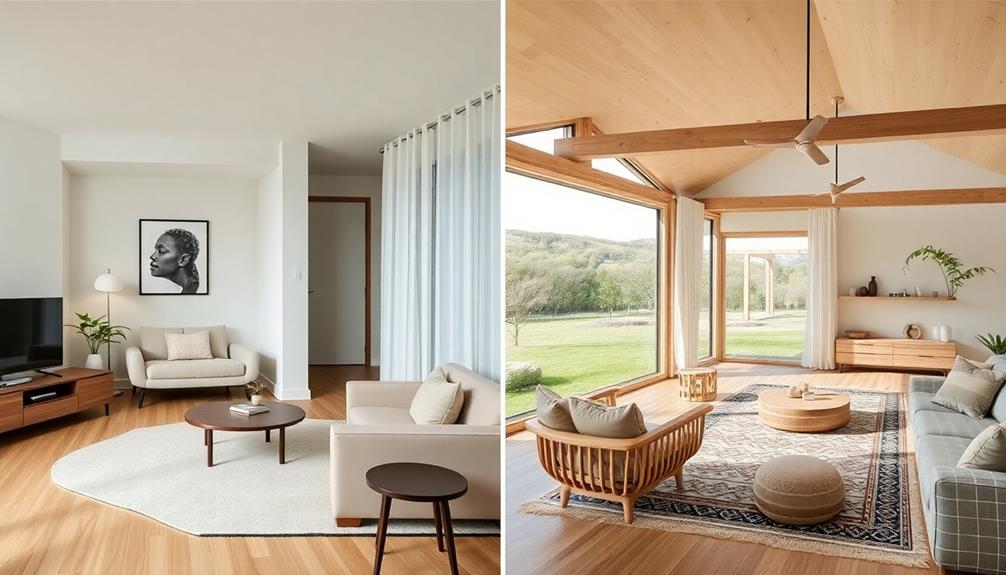
In urban interiors, you'll often find a focus on vertical space optimization, using multi-functional furniture to make the most of limited square footage.
Open floor plans create a sense of spaciousness that's essential in city living. Additionally, elements from tropical villa plans can influence urban designs by integrating outdoor living areas, making even smaller spaces feel more expansive.
In contrast, rural spaces allow for larger, standalone pieces that fill distinct, separate rooms.
Vertical Space Optimization
Many urban interiors make the most of vertical space to combat the challenges of limited floor area. You'll often find shelving, wall-mounted furniture, and multi-functional designs that help maximize every inch of your compact living area. Tall cabinets and hanging storage options not only provide organization but also maintain an open feel, essential in smaller spaces.
To further enhance these environments, urban designs might also incorporate vibrant colors and cultural motifs, reminiscent of Indonesian wedding decor ideas, which can add a unique touch to the decor.
In contrast, rural interiors usually offer more expansive layouts, which means you might prioritize lower storage solutions and horizontal space. Here, wide furniture pieces and expansive counters can create a grounded aesthetic, but they may limit your vertical options. While urban settings cleverly use vertical elements, rural designs lean towards spaciousness and comfort.
Additionally, urban designs often incorporate creative lighting that enhances the perception of height, making rooms feel larger than they are. Natural light may flood rural homes through larger windows, fostering a different kind of warmth and openness.
Open Floor Plans
Open floor plans are a popular choice in both urban and rural interiors, each utilizing the concept to suit their unique environments.
In urban settings, you often find these layouts maximizing space efficiency, creating a sense of spaciousness despite limited square footage. The fluid movement between rooms allows for a vibrant lifestyle where everything feels connected.
In contrast, rural interiors embrace open floor plans to foster social interaction, blending kitchens, dining, and living areas into multifunctional spaces that reflect the surrounding natural beauty, similar to modern tropical aesthetics.
Consider the emotional impact of these designs:
- Connection: Open floor plans encourage family gatherings and shared moments.
- Versatility: You can easily adapt spaces for various activities, from entertaining to relaxing.
- Light and Air: The absence of walls allows natural light to flow, enhancing your mood.
- Style: Urban designs often feature modern finishes, while rural spaces highlight rustic charm.
Ultimately, whether you're in the heart of a bustling city or a tranquil countryside, an open floor plan reflects a growing trend toward minimalism and multifunctionality, making your home feel more inviting and adaptable to contemporary living.
Furniture Styles
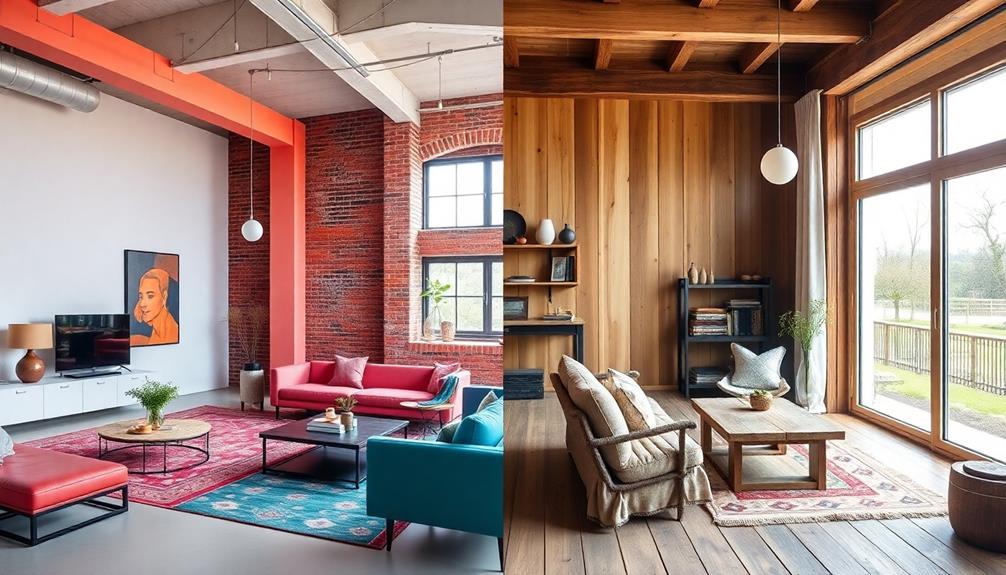
When it comes to furniture styles, urban and rural interiors present distinct aesthetics that reflect their environments. In urban spaces, you'll find minimalistic and sleek furniture designs that emphasize clean lines and monochromatic color palettes. This style projects modern sophistication, making the most of limited space with high-tech innovations and multifunctional pieces.
You might appreciate how these elements maximize efficiency while maintaining a stylish look. Additionally, urban decor often incorporates unique decorative pieces such as Indonesian decor masks that enhance the overall aesthetic and provide a cultural touch.
On the other hand, rural interiors embrace cozy, rustic furnishings crafted from natural materials like wood and stone. These choices create a warm and inviting atmosphere, celebrating traditional craftsmanship.
If you walk into a rural home, you might notice vintage or antique pieces that add character and tell a story, connecting the space to local heritage.
The contrast extends to upholstery as well. In urban settings, durable, high-performance fabrics dominate, ensuring that your furniture can withstand the hustle and bustle of city life.
In contrast, rural designs often feature softer textiles like cotton and linen, prioritizing comfort and warmth. Ultimately, the furniture styles you choose can profoundly influence how you experience your living space, reflecting either the streamlined urban vibe or the inviting charm of the countryside.
Light and Atmosphere
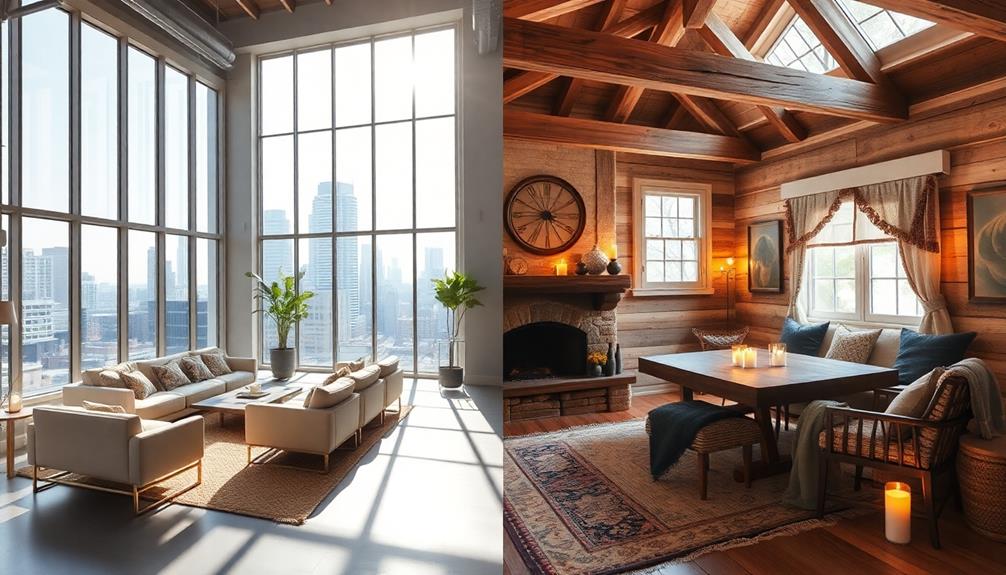
Light plays an essential role in defining the atmosphere of urban and rural interiors. In urban spaces, you'll find large windows and open layouts that invite natural light, creating a bright and airy feel. This complements the sleek, modern design you've come to appreciate.
In addition, urban decor often incorporates elements that reflect cultural diversity, such as Face Indonesian Decor Masks, which can add a unique touch to contemporary settings.
On the other hand, rural interiors often feature smaller windows and cozy nooks, using warm, soft lighting to create a sense of comfort and intimacy.
Here are some emotions you might experience based on lighting differences:
- Vibrancy: Urban lighting enhances the energy of city life, making you feel alive and connected.
- Serenity: Rural lighting fosters tranquility, allowing you to unwind and appreciate the calmness of nature.
- Warmth: The rustic charm of traditional fixtures in rural homes wraps you in a comforting embrace.
- Clarity: The clean, minimalist approach in urban settings can bring a sense of focus and clarity to your mind.
Ultimately, whether you're drawn to the dynamic ambiance of a city or the peacefulness of the countryside, the way light influences your surroundings shapes your experience profoundly.
Cultural Influences
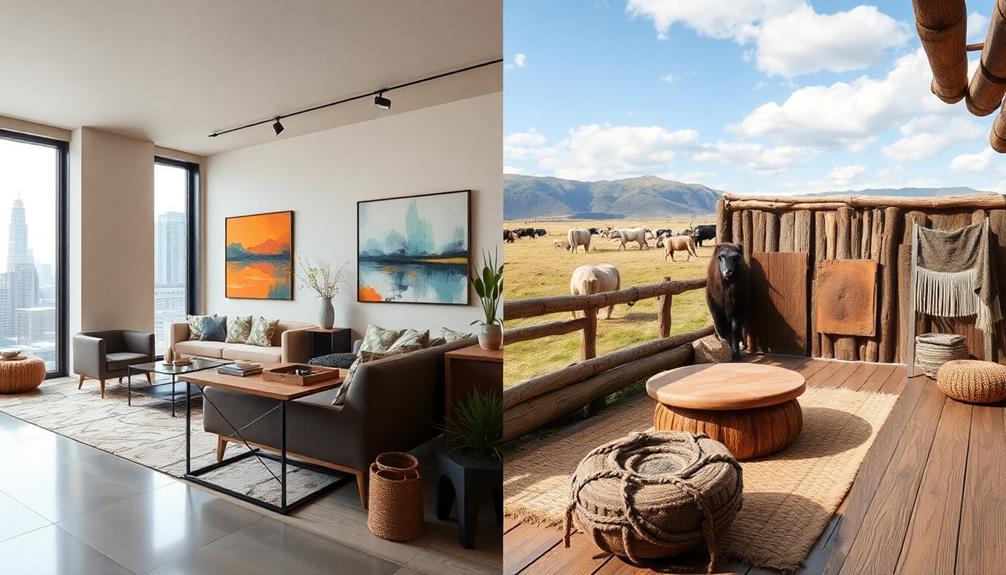
The atmosphere you experience in a space is deeply influenced by cultural factors that shape urban and rural interiors. In urban settings, you'll notice a blend of global influences, with contemporary styles celebrating multiculturalism and modern trends. This often manifests in high-tech innovations and minimalist aesthetics, reflecting your fast-paced lifestyle.
On the other hand, rural interiors emphasize local craftsmanship and traditional designs, showcasing the region's heritage through rustic elements and handmade items that tell a story.
When it comes to spatial design, urban residences prioritize functional layouts to accommodate diverse lifestyles, while rural homes focus on creating inviting communal areas that promote gatherings and foster community ties.
Regarding color, urban palettes often lean toward monochromatic and neutral tones, conveying sophistication, while rural designs burst with vibrant colors and natural hues that mirror the landscape.
Art in urban spaces frequently addresses global issues and contemporary themes, whereas rural homes tend to display artwork that celebrates nature, agriculture, and local history, reinforcing a strong sense of place and identity.
These cultural influences shape your experience, making each environment uniquely reflective of its surroundings.
Personalization and Decor
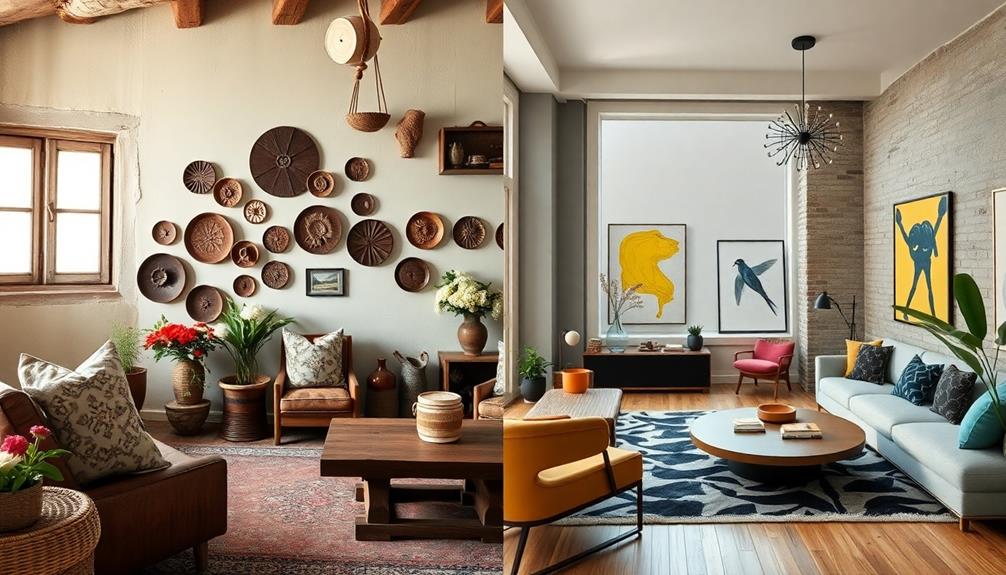
When you step into an urban home, you'll notice a clean, minimalist vibe that prioritizes sleek lines and functionality.
In contrast, rural interiors burst with personality, showcasing vibrant decor that reflects personal tastes and local culture.
This stark difference highlights how your environment influences your choices in personalization and decor.
Urban Minimalism vs. Rural Vibrancy
Many urban dwellers embrace minimalism in their interiors, opting for clean lines and a sleek, monochromatic palette that reflects a modern lifestyle. This approach prioritizes functionality, creating clutter-free spaces that promote a sense of calm.
In contrast, rural interiors burst with vibrancy, showcasing personalized decor that celebrates warmth and community. Here, natural materials and rich color palettes tell stories of local culture and heritage.
You might find these differences particularly striking:
- Wall Art: Urban spaces often limit wall decorations, while rural homes overflow with eclectic art that reflects personal expression.
- Color Choices: Urban settings typically favor high-gloss, expensive paints, but rural homes embrace more affordable finishes that add charm.
- Functional Design: Minimalism in urban areas focuses on sleekness, whereas rural designs incorporate cozy elements that invite you to relax.
- Personal Touch: Rural interiors highlight diverse decor choices that foster a sense of belonging, contrasting sharply with the sterile elegance of urban spaces.
Understanding these differences can help you appreciate how each environment shapes its inhabitants' lifestyles and perspectives.
Personalized Aesthetics in Interiors
Personalized aesthetics in interiors play an essential role in how individuals express their identities and lifestyles. In urban settings, you often find minimalistic designs that prioritize functionality over personal flair. This results in fewer decor elements that resonate with your unique tastes. Conversely, rural interiors tend to showcase vibrant and eclectic styles, allowing for a richer expression of personal history and culture.
Here's a comparison of personalized aesthetics in urban and rural interiors:
| Aspect | Urban Interiors | Rural Interiors |
|---|---|---|
| Design Style | Minimalism, sleek lines | Eclectic, warm, and charming |
| Color Palette | Monochromatic, sophisticated | Varied, whimsical, and inviting |
| Materials | Modern, high-tech features | Natural, handmade items |
| Decor Influence | Contemporary trends, designer focus | Individual creativity, nostalgic items |
In urban homes, you're likely to see decor that reflects current trends, while rural spaces celebrate personal stories through family heirlooms. By understanding these differences, you can appreciate how your surroundings influence your aesthetic choices.
Functionality vs. Aesthetics
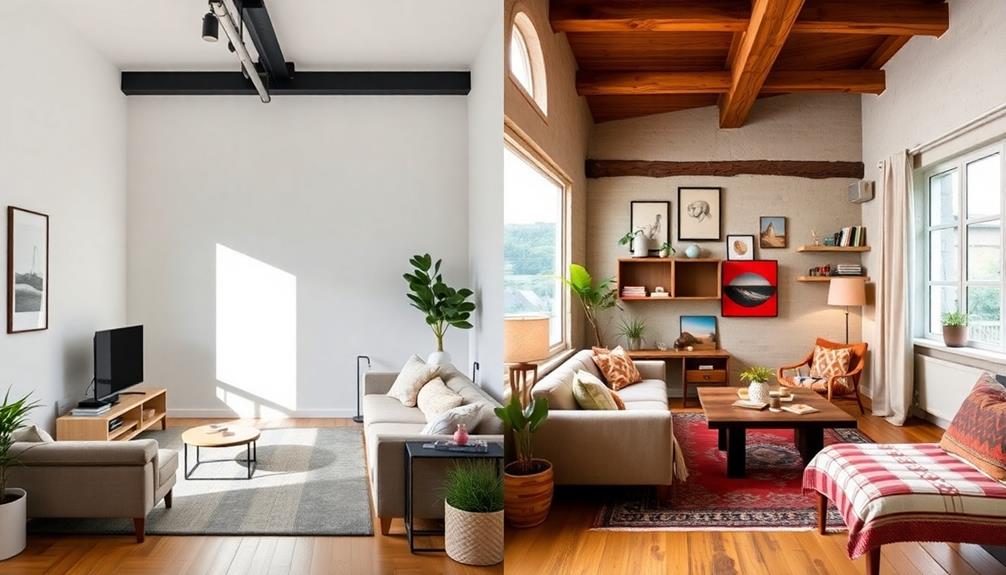
Balancing functionality and aesthetics is a defining characteristic of urban and rural interiors. In urban spaces, you'll often find a strong emphasis on practicality. Multi-purpose furniture maximizes small areas, while sleek, minimalist designs keep your environment clutter-free.
You might appreciate cutting-edge technology that enhances convenience, all tailored for your busy lifestyle.
In contrast, rural interiors invite you to embrace aesthetics. You can indulge in vintage furnishings and handcrafted decorations that create warmth and charm. The focus shifts to sustainable materials, celebrating craftsmanship and a connection to nature.
Here, leisurely, open layouts encourage social gatherings, allowing you to cherish family interactions.
Consider these emotional aspects as you explore the differences:
- Comfort: Urban spaces often feel rushed, while rural interiors embrace a cozy atmosphere.
- Connection: Rural designs celebrate your personal style, fostering a sense of belonging.
- Efficiency: Urban areas prioritize functionality, catering to fast-paced lives.
- Warmth: Rural interiors invite you to slow down and appreciate your surroundings.
Ultimately, the balance between functionality and aesthetics shapes your living experience, reflecting your values and lifestyle preferences.
Community and Social Spaces
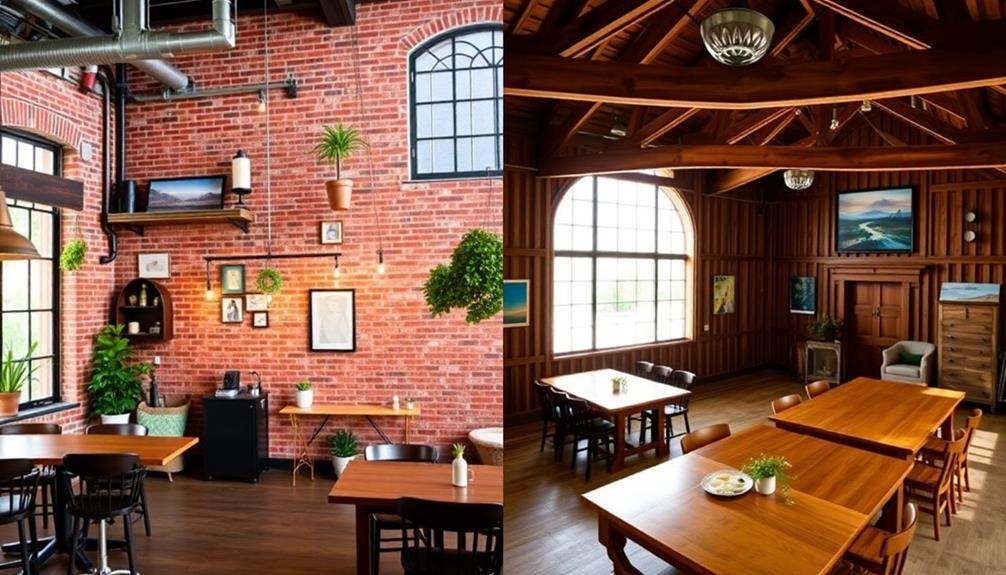
The design of community and social spaces reveals stark contrasts between urban and rural interiors, reflecting their unique lifestyles and values. In urban settings, you'll often find open-plan layouts and multifunctional areas that cater to your fast-paced life and limited square footage. These spaces might include rooftop gardens or lounges, providing a sense of community amid the bustling city.
In contrast, rural interiors prioritize larger communal areas, fostering family gatherings and social interactions. You'll notice an emphasis on warmth and coziness, with large dining tables and comfortable seating that invite shared meals and social activities.
Rural designs often incorporate natural materials and outdoor views, creating a connection to the landscape that promotes social gatherings. Ultimately, whether you're in a busy city or a serene countryside, community and social spaces reflect how you live and connect with others.
Urban designs aim for efficiency while maintaining a sense of community, whereas rural spaces cultivate intimacy and hospitality, inviting you to slow down and enjoy shared moments with loved ones. Each approach offers distinct advantages, catering to the unique needs of their respective environments.
Frequently Asked Questions
What Are 5 Differences Between Urban and Rural?
You'll notice urban areas often feature modern design and technology, while rural settings prioritize natural materials and coziness. Urban spaces lean towards minimalist aesthetics, whereas rural environments embrace inviting communal areas and local craftsmanship.
How Are Rural and Urban Settings Different?
You'll notice rural settings often prioritize tranquility and nature, while urban areas buzz with energy and modernity. Each offers unique lifestyles, with rural spaces emphasizing rustic charm and urban environments showcasing sleek, innovative designs.
What Is the Most Appropriate Factor Used to Differentiate Between Rural and Urban Areas?
To differentiate between rural and urban areas, you'll find population density is key. Urban areas are densely populated with buildings, while rural regions offer open spaces, farms, and smaller communities, shaping their unique characteristics.
What Do You Think Are the Biggest Differences Between Urban and Rural Areas?
You might think urban and rural areas share more similarities than differences, but they actually diverge considerably. Urban areas focus on modern convenience and high density, while rural ones embrace tradition, space, and natural beauty.
Conclusion
In the delightful dance between urban and rural interiors, you'll find a treasure trove of choices that reflect your unique style. Whether you lean towards the bustling charm of city life or the serene simplicity of the countryside, each space tells a story. Embrace the subtle nuances in design philosophy and decor, and let your home be a beautiful representation of where you've come from and where you're headed. After all, every corner holds a whisper of inspiration waiting to be uncovered.
Home Decor
Late Summer Decor Secrets That Will Completely Transform Your Home!
Step into the world of late summer decor secrets that will beautifully transition your home—discover the simple changes that can make a big impact!
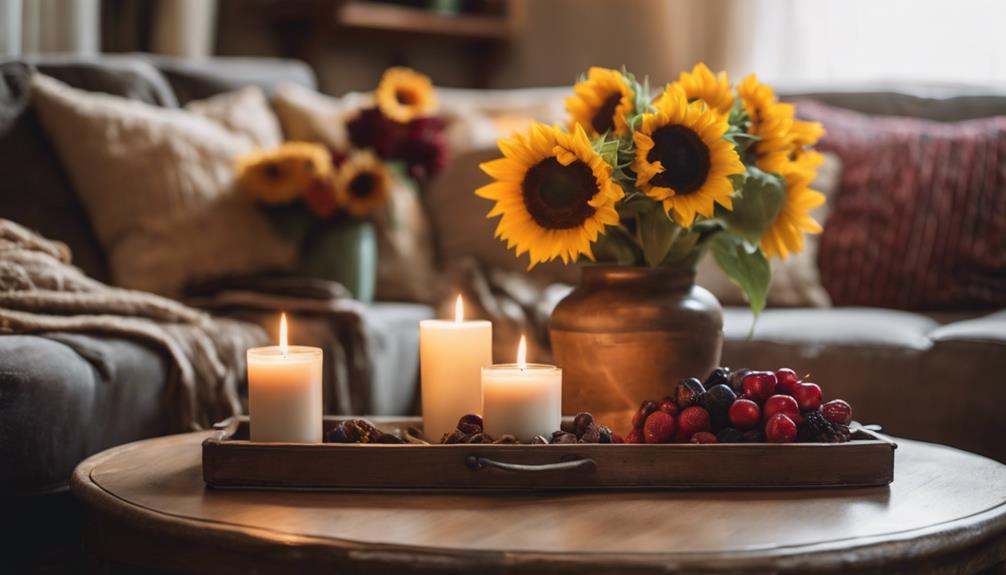
To transform your home for late summer, swap out bright pillows for rich, textured options in warm tones like deep reds and browns. Incorporate seasonal accents, such as dried hydrangeas and cozy textiles like chunky throws to create a welcoming atmosphere. Opt for stylish storage baskets to reduce clutter and display decorative bowls filled with fresh fruits for a pop of color. Finally, showcase family heirlooms for a personal touch. These simple adjustments will elevate your space, blending summer's vibrancy with autumn's warmth. If you're enthusiastic for more innovative ideas, there's plenty more to uncover!
Key Takeaways
- Swap lightweight summer throws for deeper, textured options in rich colors to create a cozy atmosphere.
- Incorporate seasonal blooms in textured vases and decorative bowls filled with fresh fruits for vibrant decor.
- Layer cozy textiles like chunky throws and velvet pillows to enhance comfort and warmth in your space.
- Display family heirlooms to add personal touches and create meaningful conversation starters during gatherings.
Seasonal Decor Transition Tips
As summer fades, you can easily adjust your decor by introducing warm autumn tones and cozy textures that instantly evoke the spirit of fall.
Begin with simple changes—swap out your colorful summer pillows for deeper, textured options in rich reds, oranges, and browns. This quick update adds immediate warmth and reflects your love for seasonal decorating.
To further adapt to fall, incorporate beautiful home accents like dried hydrangeas and brown glass bottles. These touches of fall not only maintain visual interest but also celebrate the essence of autumn.
Layer cozy textiles, such as chunky throws and velvet pillows, to enhance comfort as the weather cools down.
Don't forget that engaging with fellow decorators through social media can spark inspiration for your decor journey. Share your favorite summer decorating tips and discover new ideas to make your home feel even cozier.
Essential Late Summer Decor Items
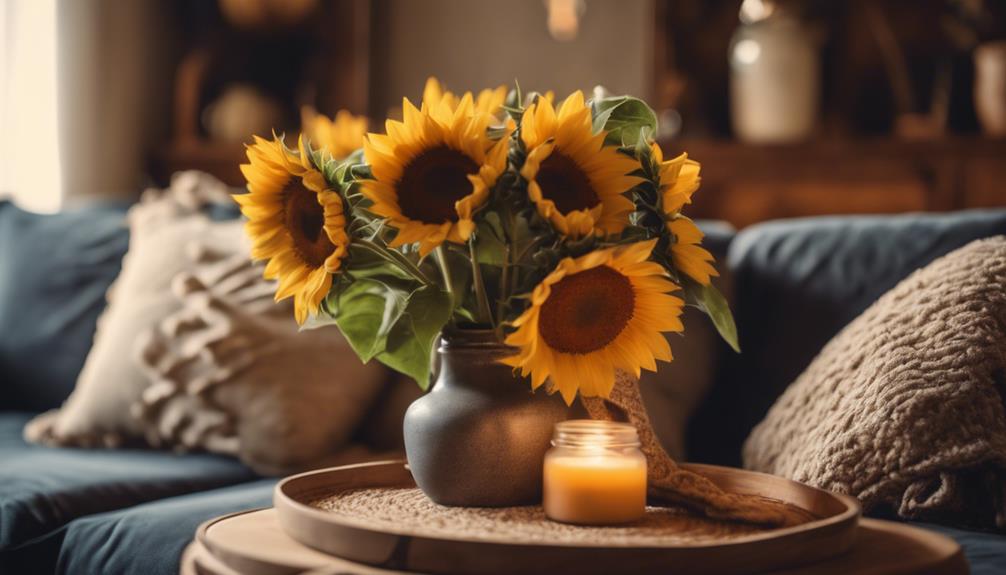
To keep your home feeling fresh and inviting as summer winds down, consider incorporating vibrant late summer decor items that celebrate the season's beauty.
Start with lightweight throws in bright patterns, which add a pop of color while providing warmth for those cooler evenings. These versatile pieces are perfect for shifting decor.
Next, use textured vases filled with seasonal blooms like sunflowers or cotton stems. These not only introduce natural elements but also enhance your decor with fresh, lively hues.
To maintain an organized space, opt for stylish storage options, such as baskets made from natural materials. They add an inviting touch while keeping your home clutter-free.
Don't forget about decorative bowls! Fill them with fresh fruits like apples and pears to brighten your kitchen and celebrate the bounty of late summer.
These simple yet effective summer decor ideas can transform your home, ensuring it remains a welcoming retreat as you shift into fall.
Color and Texture Adjustments
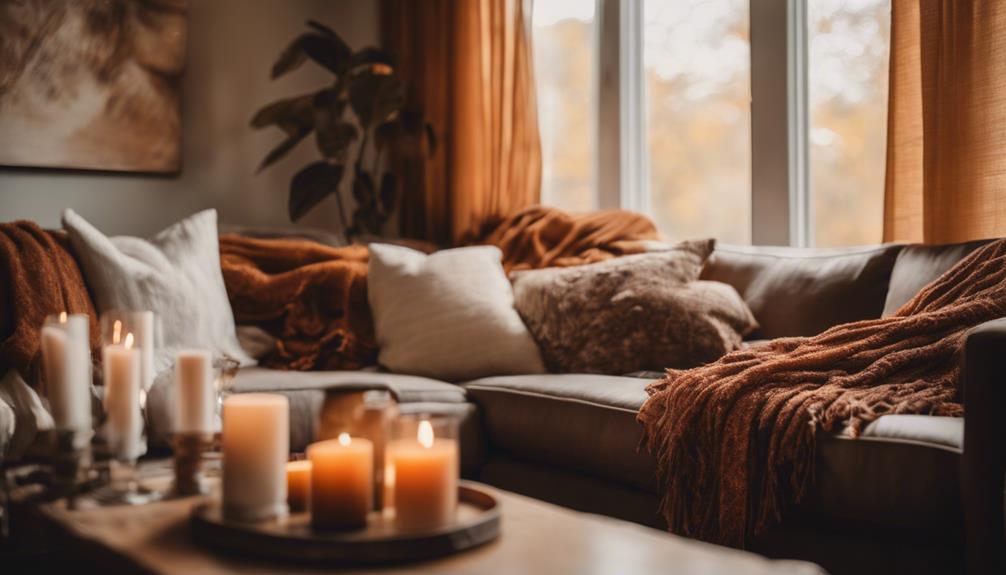
Embrace the shift in seasons by swapping out bright summer colors for warm earthy tones that instantly create a cozy autumn atmosphere in your home. Start by introducing deep browns, greens, and reds into your decor. These colors not only evoke the essence of fall but also make your space feel inviting.
Next, focus on cozy textiles. Incorporate chunky throws and velvet pillows to add warmth and texture, enhancing comfort throughout your rooms. Mixing various textures, like wool and flannel with natural elements such as burlap and wicker, adds visual depth and interest to your decor.
Don't hesitate to layer neutral shades like beige, cream, and gray with bold accent colors. For example, navy blue pillows paired with white pumpkins provide a stylish, non-traditional touch to your late summer decor. This layering technique helps balance your color palette while allowing seasonal hues to pop.
Incorporating Family Heirlooms
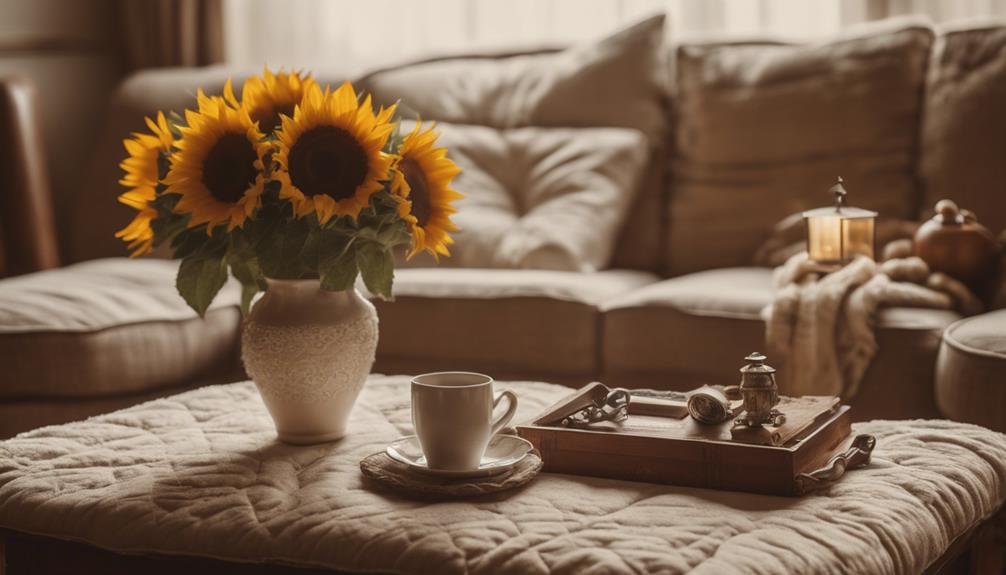
Incorporating family heirlooms into your decor not only adds a personal touch but also weaves your family's history into the fabric of your home. These treasured items carry sentimental value, transforming your space into a personalized atmosphere rich with stories. Think about displaying vintage pottery or cherished items that spark conversation starters during family gatherings.
| Heirloom Item | Sentimental Value |
|---|---|
| Grandmother's vase | Reminds you of her warmth and love |
| Father's football helmet | Evokes memories of game days together |
| Antique clock | Symbolizes the passage of time and traditions |
| Old family photos | Captures moments of joy and laughter |
| Great-grandfather's chair | Represents continuity through generations |
Utilizing these heirlooms in your decor fosters a sense of belonging and continuity, binding past generations with the present. You can even rotate these items with seasonal decor changes to keep your home fresh while honoring your family's legacy. This approach not only enriches your home transformation but also creates a comforting environment filled with cherished memories.
Engaging With Decor Communities
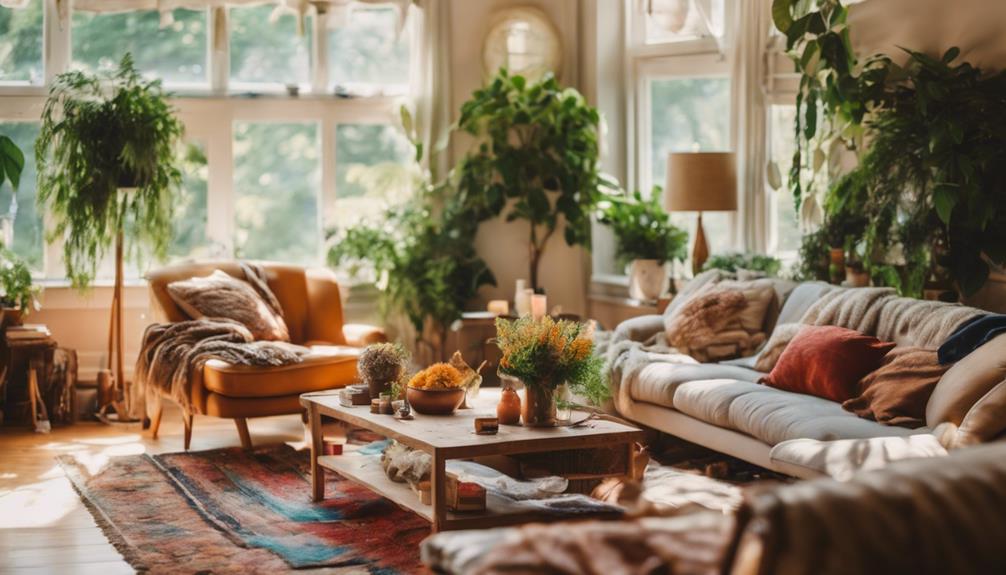
Engaging with decor communities can spark new ideas and inspire your decorating journey by connecting you with a diverse group of fellow enthusiasts. When you immerse yourself in these vibrant communities, you'll find a wealth of inspiration and support that can elevate your home decor.
Participate in home tours to showcase your style and see how others incorporate fall touches.
Join seasonal challenges that encourage creativity and fresh ideas for your decor.
Exchange valuable feedback and insights with fellow decorators to refine your techniques.
Attend online forums where you can seek advice and share personal stories about your decorating experiences.
Frequently Asked Questions
How Can I Decorate for Late Summer?
To decorate for late summer, you can incorporate vibrant colors, fresh floral arrangements, and lighter fabrics. Use seasonal fruits as decor, embrace versatile patterns, and add natural elements for warmth and texture in your space.
What Decor Do You Use in August?
In August, you can brighten your space with colorful pillows and seasonal fruits. Swap bright florals for sunflowers, and add natural elements like olive branches to create a welcoming, shifting atmosphere as summer fades.
How Do You Transition From Summer to Fall Decor?
To shift from summer to fall decor, start incorporating warm hues, cozy textiles, and natural elements. Swap out bright colors for earthy tones, use seasonal florals, and embrace textures that evoke the comforting essence of autumn.
What Do You Decorate for in September?
As summer gracefully takes its leave, you'll want to embrace September's charm. Incorporate warm hues, cozy textiles, and seasonal accents like pumpkins and leaves to cultivate a welcoming atmosphere that celebrates the beauty of autumn.
Conclusion
As you embrace these late summer decor secrets, you might just find your home transforming in ways you never expected.
It's funny how a simple change in color or adding a cherished family heirloom can spark joy and nostalgia. Suddenly, your space feels fresh and inviting, perfect for cozy gatherings.
So go ahead, immerse yourself in those decor communities and share your journey—who knows, you might inspire someone else while discovering even more tricks along the way!
-

 Vetted4 months ago
Vetted4 months ago14 Best Personalized Father's Day Gifts for Your Husband – Show Him You Care
-

 Alfresco4 months ago
Alfresco4 months agoAlfresco Stacker Doors: Seamless Indoor-Outdoor Living!
-

 Craft and Textiles5 months ago
Craft and Textiles5 months ago15 Best Places to Buy Appliances for Your Home – Top Retailers Reviewed
-

 Vetted5 months ago
Vetted5 months ago15 Best EMS Foot Massagers for Neuropathy to Soothe Your Feet
-

 Decorative Throws5 months ago
Decorative Throws5 months agoIs It Better to Dry Clean Blankets?
-

 Tableware and Dining Accessories5 months ago
Tableware and Dining Accessories5 months agoWhat Is the Hindi Meaning of Tableware
-

 Craft and Textiles5 months ago
Craft and Textiles5 months ago15 Best Gifts for 4-Year-Old Girls That Will Spark Joy and Creativity
-

 Craft and Textiles5 months ago
Craft and Textiles5 months ago15 Best Cordless Mowers for Effortless Lawn Care – Top Picks of 2024










